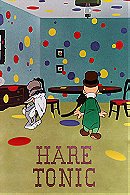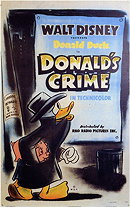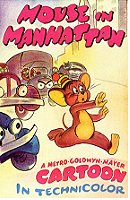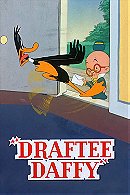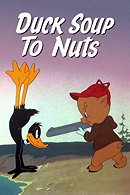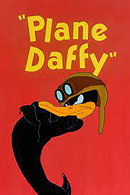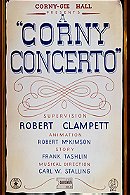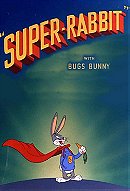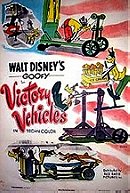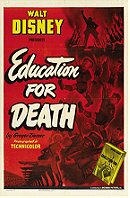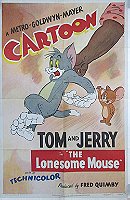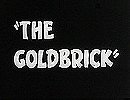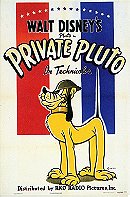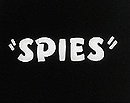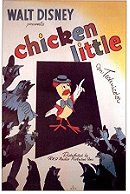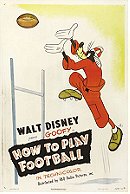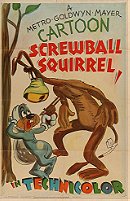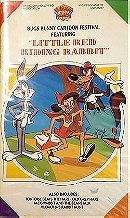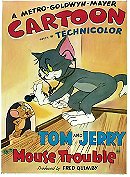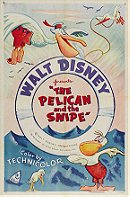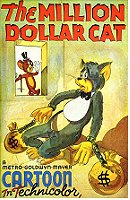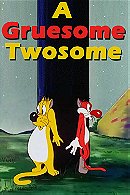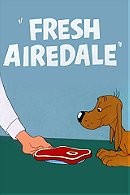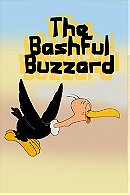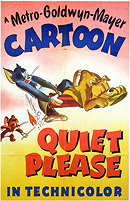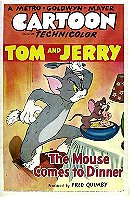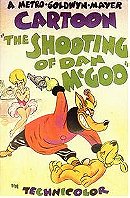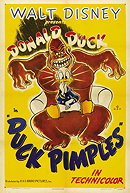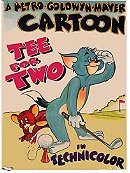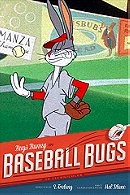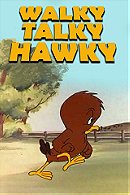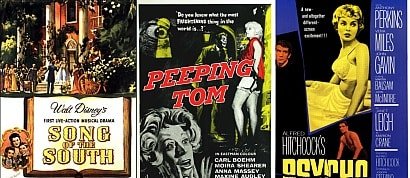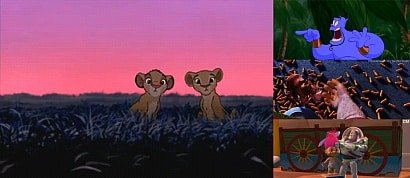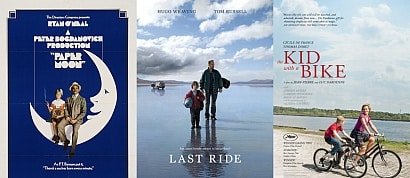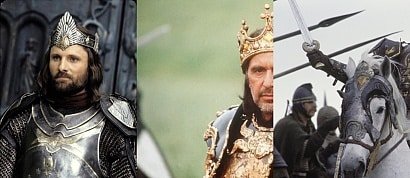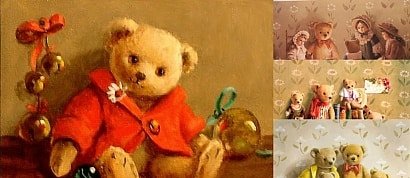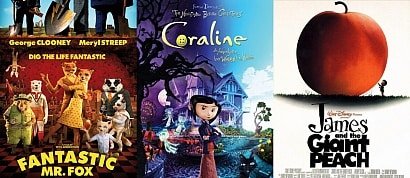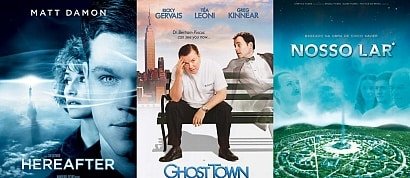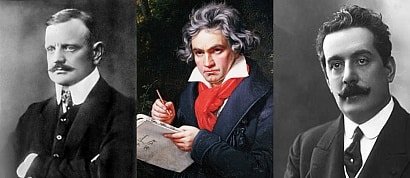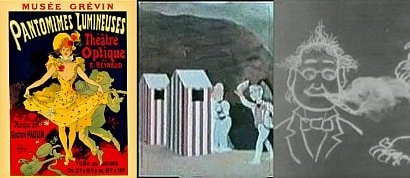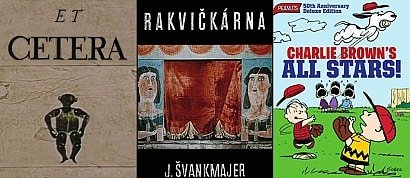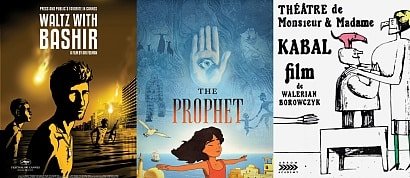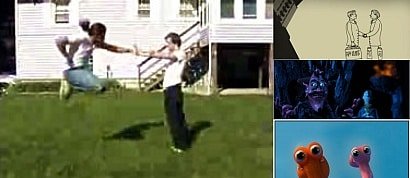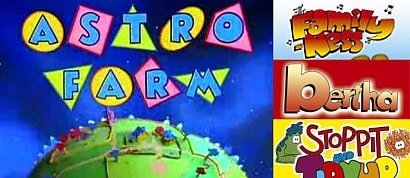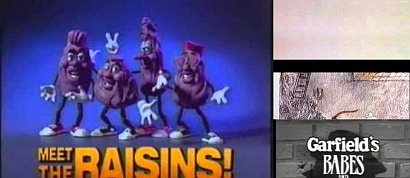1001 Animated Shorts You Must See - Part 4
Sort by:
Showing 50 items
Decade:
Rating:
List Type:
DIR: Frank Tashlin
SUMMARY: Unable to pay their bill, Porky and Daffy attempt to escape from a hotel.
WHY IT'S HERE: Frank Tashlin's 'Porky Pig's Feat' is an exceptionally handsome black and white cartoon. Trapped in a hotel with a bill they can't pay, Porky Pig and Daffy Duck attempt to rid themselves of the fearsome manager and escape. It's a simple set up for a fast paced and very funny short. There are several things that make 'Porky Pig's Feat' notable besides its general excellence. The drawing and animation style have an unusually modern feel to them for 1943 and the camera angles and set-ups have a really cinematic feel to them. Witness Daffy's wild rush down the corridor and into the elevator or Porky and Daffy as they swing on a rope made of sheets from the hotel window. Perhaps the most notable element, however, is a last minute cameo from (a rather odd sounding) Bugs Bunny who makes his only appearance in black and white and his first appearance alongside Porky and Daffy. Although it was still early in Bugs' career, he had already outshone all the studio's previous stars in terms of popularity and this is reflected in Porky and Daffy's hero worship of him. It's slightly odd to hear Daffy proclaiming that Bugs is his hero in light of their more famous rivalry developed by Chuck Jones in later years. All these unusual elements help make 'Porky Pig's Feat' a classic but, crucially, it also has a great script and a wonderful energy that drives it forward until its great surprise ending. One of Tashlin's best films.
SUMMARY: Unable to pay their bill, Porky and Daffy attempt to escape from a hotel.
WHY IT'S HERE: Frank Tashlin's 'Porky Pig's Feat' is an exceptionally handsome black and white cartoon. Trapped in a hotel with a bill they can't pay, Porky Pig and Daffy Duck attempt to rid themselves of the fearsome manager and escape. It's a simple set up for a fast paced and very funny short. There are several things that make 'Porky Pig's Feat' notable besides its general excellence. The drawing and animation style have an unusually modern feel to them for 1943 and the camera angles and set-ups have a really cinematic feel to them. Witness Daffy's wild rush down the corridor and into the elevator or Porky and Daffy as they swing on a rope made of sheets from the hotel window. Perhaps the most notable element, however, is a last minute cameo from (a rather odd sounding) Bugs Bunny who makes his only appearance in black and white and his first appearance alongside Porky and Daffy. Although it was still early in Bugs' career, he had already outshone all the studio's previous stars in terms of popularity and this is reflected in Porky and Daffy's hero worship of him. It's slightly odd to hear Daffy proclaiming that Bugs is his hero in light of their more famous rivalry developed by Chuck Jones in later years. All these unusual elements help make 'Porky Pig's Feat' a classic but, crucially, it also has a great script and a wonderful energy that drives it forward until its great surprise ending. One of Tashlin's best films.
DIR: William Hanna, Joseph Barbera
SUMMARY: Tom and Jerry stage a microcosm of WWII when their chase takes them into the basement.
WHY IT'S HERE: MGM's 'The Yankee Doodle Mouse' was the third Tom & Jerry cartoon to be nominated for the Oscar and the first to win. The first of many, as the cat and mouse duo would dominate the awards for the next decade. 'The Yankee Doodle Mouse' is another war themed cartoon in which Tom and Jerry stage their own microcosm of war in a basement. During this battle, a number of household objects ingeniously stand-in for grenades, helmets, planes, jeeps and gas. It's beautifully conceived and executed and was a clear sign of how quickly the hugely popular series was developing in quality. Six further Oscar wins would confirm this. The wartime theme, aside from the rousing patriotic ending, is mostly played for laughs and while it was this theme probably helped guide the wartime Academy members hands in choosing it as the year's winner, it was a more than deserving choice. 'The Yankee Doodle Mouse' remains one of the most impressive cartoons in a series packed with amazing films.
SUMMARY: Tom and Jerry stage a microcosm of WWII when their chase takes them into the basement.
WHY IT'S HERE: MGM's 'The Yankee Doodle Mouse' was the third Tom & Jerry cartoon to be nominated for the Oscar and the first to win. The first of many, as the cat and mouse duo would dominate the awards for the next decade. 'The Yankee Doodle Mouse' is another war themed cartoon in which Tom and Jerry stage their own microcosm of war in a basement. During this battle, a number of household objects ingeniously stand-in for grenades, helmets, planes, jeeps and gas. It's beautifully conceived and executed and was a clear sign of how quickly the hugely popular series was developing in quality. Six further Oscar wins would confirm this. The wartime theme, aside from the rousing patriotic ending, is mostly played for laughs and while it was this theme probably helped guide the wartime Academy members hands in choosing it as the year's winner, it was a more than deserving choice. 'The Yankee Doodle Mouse' remains one of the most impressive cartoons in a series packed with amazing films.
DIR: Chuck Jones
SUMMARY: Bugs Bunny convinces Elmer Fudd that he had contracted the dreaded Rabbititus.
WHY IT'S HERE:Chuck Jones's 'Hare Tonic' is a brilliant but little known cartoon. Deliciously sick, 'Hare Tonic' involves Bugs Bunny convincing the hapless Elmer Fudd that he has caught the dreaded Rabbititus! Taking place almost entirely in Elmer's suburban home, 'Hare Tonic's' success is entirely down to Bugs's inspired heckling. He is never in any real danger (he forfeits an easy escape early on in the cartoon in order to have some fun torturing Elmer) and is therefore free to carry his devilish bluff to the extreme, convincing Elmer that he is trapped quarantined with an infectious rabbit. In contrast with cartoons in which Bugs heckles his opponent in a variety of different ways, 'Hare Tonic' simply extends one routine across the whole seven minutes and it works fantastically, right up to the great fourth-wall breaking climax. While it doesn't quite weigh in with Jones's all time classics (and bear in mind the level of quality that involves), 'Hare Tonic' is still a lesser known piece of sheer brilliance that I would recommend to anyone.
SUMMARY: Bugs Bunny convinces Elmer Fudd that he had contracted the dreaded Rabbititus.
WHY IT'S HERE:Chuck Jones's 'Hare Tonic' is a brilliant but little known cartoon. Deliciously sick, 'Hare Tonic' involves Bugs Bunny convincing the hapless Elmer Fudd that he has caught the dreaded Rabbititus! Taking place almost entirely in Elmer's suburban home, 'Hare Tonic's' success is entirely down to Bugs's inspired heckling. He is never in any real danger (he forfeits an easy escape early on in the cartoon in order to have some fun torturing Elmer) and is therefore free to carry his devilish bluff to the extreme, convincing Elmer that he is trapped quarantined with an infectious rabbit. In contrast with cartoons in which Bugs heckles his opponent in a variety of different ways, 'Hare Tonic' simply extends one routine across the whole seven minutes and it works fantastically, right up to the great fourth-wall breaking climax. While it doesn't quite weigh in with Jones's all time classics (and bear in mind the level of quality that involves), 'Hare Tonic' is still a lesser known piece of sheer brilliance that I would recommend to anyone.
DIR: Jack King
SUMMARY: Donald Duck struggles with his conscience when he steals from his nephews' piggy bank to fund his date with Daisy.
WHY IT'S HERE: 'Donald's Crime' is an interesting homage to Film Noir in which we get a glimpse into Donald's guilt ridden psyche after he steals from his nephews. The best parts of the cartoon are the numerous representations of Donald's psychological state as the guilt takes hold, culminating in the final Noirish struggle with the voices in his head as he battles his way through the night, avoiding spotlights and imagining wanted posters of his image. Ultimately 'Donald's Crime' perhaps needed to commit itself to its darker ideas more, as the light and shade are a little awkwardly balanced, but it's a fine film which earned an Oscar nomination for Best Animated Short.
SUMMARY: Donald Duck struggles with his conscience when he steals from his nephews' piggy bank to fund his date with Daisy.
WHY IT'S HERE: 'Donald's Crime' is an interesting homage to Film Noir in which we get a glimpse into Donald's guilt ridden psyche after he steals from his nephews. The best parts of the cartoon are the numerous representations of Donald's psychological state as the guilt takes hold, culminating in the final Noirish struggle with the voices in his head as he battles his way through the night, avoiding spotlights and imagining wanted posters of his image. Ultimately 'Donald's Crime' perhaps needed to commit itself to its darker ideas more, as the light and shade are a little awkwardly balanced, but it's a fine film which earned an Oscar nomination for Best Animated Short.
DIR: William Hanna, Joseph Barbera
SUMMARY: Tired of country life, Jerry writes Tom a goodbye note and heads off for the bright lights of Manhattan... but it prove to be a tougher city than he expected.
WHY IT'S HERE: Of all the experiments Hanna and Barbera made in this era of Tom and Jerry shorts, 'Mouse in Manhattan' is probably the most audacious. After all, Tom and Jerry were a duo and audiences expected to always see them together. So the idea of making a solo Jerry cartoon in which Tom makes only a cameo was a bold move indeed. Luckily, it works beautifully, although the absence of Tom in favour of an entire city as Jerry's opponent is perhaps the reason this exquisite short remains underrated. Throughout its runtime 'Mouse in Manhattan aspires to Disney realism, offering us a beautiful depiction of New York at night. One would expect Jerry to be an insipid character without Tom to play off but he proves more than affable company throughout. But it is the sparkling visuals that are the real star of 'Mouse in Manhattan', and it emerges as one of the most immersive of cartoons I can think of. When Jerry returns to Tom at the end we are still relieved to see the pair reunited and there is no desire to see any more solo Jerry outings, but that is because 'Mouse in Manhattan' nailed it first time out and there is no need to attempt to improve on such a wonderful cartoon.
SUMMARY: Tired of country life, Jerry writes Tom a goodbye note and heads off for the bright lights of Manhattan... but it prove to be a tougher city than he expected.
WHY IT'S HERE: Of all the experiments Hanna and Barbera made in this era of Tom and Jerry shorts, 'Mouse in Manhattan' is probably the most audacious. After all, Tom and Jerry were a duo and audiences expected to always see them together. So the idea of making a solo Jerry cartoon in which Tom makes only a cameo was a bold move indeed. Luckily, it works beautifully, although the absence of Tom in favour of an entire city as Jerry's opponent is perhaps the reason this exquisite short remains underrated. Throughout its runtime 'Mouse in Manhattan aspires to Disney realism, offering us a beautiful depiction of New York at night. One would expect Jerry to be an insipid character without Tom to play off but he proves more than affable company throughout. But it is the sparkling visuals that are the real star of 'Mouse in Manhattan', and it emerges as one of the most immersive of cartoons I can think of. When Jerry returns to Tom at the end we are still relieved to see the pair reunited and there is no desire to see any more solo Jerry outings, but that is because 'Mouse in Manhattan' nailed it first time out and there is no need to attempt to improve on such a wonderful cartoon.
DIR: Bob Clampett
SUMMARY: Daffy Duck's patriotism is put to the test when he himself receives call-up papers.
WHY IT'S HERE: Bob Clampett's 'Draftee Daffy' is a remarkable cartoon in many respects. Of course, there is its extraordinary energy, phenomenal facial expressions, a great voice characterisation from Mel Blanc. But most of all, 'Draftee Daffy' is incredible because it is a wartime cartoon which acknowledges the horror of being called up to serve your country. Daffy starts the cartoon as a flag-waving patriot singing the praises of the American troops fighting fascism. When he receives a call saying that the man from the draft board is coming to see him however, Daffy's demeanour changes and he falls apart at the prospect of going to war himself. He spends the rest of the cartoon frantically trying to avoid receiving his call-up papers. Only Daffy Duck could have gotten away with such flagrantly unpatriotic behaviour during wartime and still have the audience root for him. While nearly every film, animated or live action, was depicting Americans as willing and eager to serve their country, 'Draftee Daffy' acknowledges the horror of what lay in wait for draftees and the terror they must have felt. Clampett emphasises this by Daffy's absolute insanity at the prospect of being sent to the hellish battlefields, to the extent that he's willing to commit murder and is actually relieved when he finds himself in hell at the end of the cartoon, assuming that at least he is safe from the trenches. In many ways, 'Draftee Daffy' is a deadly serious cartoon about real people's fear of being drafted into the madness of war and this adds a pleasingly dark edge to what is otherwise an absolutely hilarious short. Daffy's wild bids for freedom are animated to perfection as he literally becomes a blur in his attempts to escape the eerily calm man from the draft board. 'Draftee Daffy' is one of my favourite cartoons of all time. Not only is it massively entertaining to watch, it is also loaded with subtext and historical significance which make it a genuine landmark film.
SUMMARY: Daffy Duck's patriotism is put to the test when he himself receives call-up papers.
WHY IT'S HERE: Bob Clampett's 'Draftee Daffy' is a remarkable cartoon in many respects. Of course, there is its extraordinary energy, phenomenal facial expressions, a great voice characterisation from Mel Blanc. But most of all, 'Draftee Daffy' is incredible because it is a wartime cartoon which acknowledges the horror of being called up to serve your country. Daffy starts the cartoon as a flag-waving patriot singing the praises of the American troops fighting fascism. When he receives a call saying that the man from the draft board is coming to see him however, Daffy's demeanour changes and he falls apart at the prospect of going to war himself. He spends the rest of the cartoon frantically trying to avoid receiving his call-up papers. Only Daffy Duck could have gotten away with such flagrantly unpatriotic behaviour during wartime and still have the audience root for him. While nearly every film, animated or live action, was depicting Americans as willing and eager to serve their country, 'Draftee Daffy' acknowledges the horror of what lay in wait for draftees and the terror they must have felt. Clampett emphasises this by Daffy's absolute insanity at the prospect of being sent to the hellish battlefields, to the extent that he's willing to commit murder and is actually relieved when he finds himself in hell at the end of the cartoon, assuming that at least he is safe from the trenches. In many ways, 'Draftee Daffy' is a deadly serious cartoon about real people's fear of being drafted into the madness of war and this adds a pleasingly dark edge to what is otherwise an absolutely hilarious short. Daffy's wild bids for freedom are animated to perfection as he literally becomes a blur in his attempts to escape the eerily calm man from the draft board. 'Draftee Daffy' is one of my favourite cartoons of all time. Not only is it massively entertaining to watch, it is also loaded with subtext and historical significance which make it a genuine landmark film.
DIR: William Hanna, Joseph Barbera
SUMMARY: When Jerry frees Spike from a dogcatcher's van, the grateful bulldog tells him that any time he needs him he should just whistle, something which Jerry puts to good use in tackling his old nemesis Tom.
WHY IT'S HERE: Several of the Tom and Jerry cartoons of this period had experimented with having the cat and mouse talk to largely unsuccessful results. With 'The Bodyguard' Hanna and Barbera brought back Spike the Bulldog from their early cartoon 'Dog Trouble' but this time they gave him a voice. In doing so they invented a successfully vocal character who would go on to feature in many future Tom and Jerry cartoons and even a few starring roles of his own. 'The Bodyguard' is a great cartoon with a winningly simple premise that has been used in varying forms in many different cartoons. The 'just whistle' conceit sets up many instances of hilarious abrupt slapstick as Spike emerges unfeasibly quickly to respond to Jerry's cries for help. Also notable is the ending in which, like in the same year's 'Million Dollar Cat', Tom sort of wins. It's an unexpected and brilliantly effective moment in a series at the top of its game.
SUMMARY: When Jerry frees Spike from a dogcatcher's van, the grateful bulldog tells him that any time he needs him he should just whistle, something which Jerry puts to good use in tackling his old nemesis Tom.
WHY IT'S HERE: Several of the Tom and Jerry cartoons of this period had experimented with having the cat and mouse talk to largely unsuccessful results. With 'The Bodyguard' Hanna and Barbera brought back Spike the Bulldog from their early cartoon 'Dog Trouble' but this time they gave him a voice. In doing so they invented a successfully vocal character who would go on to feature in many future Tom and Jerry cartoons and even a few starring roles of his own. 'The Bodyguard' is a great cartoon with a winningly simple premise that has been used in varying forms in many different cartoons. The 'just whistle' conceit sets up many instances of hilarious abrupt slapstick as Spike emerges unfeasibly quickly to respond to Jerry's cries for help. Also notable is the ending in which, like in the same year's 'Million Dollar Cat', Tom sort of wins. It's an unexpected and brilliantly effective moment in a series at the top of its game.
DIR: Friz Freleng
SUMMARY: Daffy Duck heckles hunter Porky Pig.
WHY IT'S HERE: Friz Freleng's 'Duck Soup to Nuts' is one of the great Daffy-terrorizes-Porky cartoons. The quality of these simple scenario shorts depend entirely on the quality of the antagonist's heckling and in 'Duck Soup to Nuts' it is top notch. Tedd Pierce's script is hilarious giving Daffy plenty of inventive pranks and bits. Unlike Robert McKimson's weak take on this premise in 'Boobs in the Wood', 'Duck Soup to Nuts' is beautifully animated (just watch Daffy's impression of a fish) and extremely funny. Energetic and witty, the laughs keep on coming throughout, right up to the climax in which Daffy says goodbye to his hysterically named "children". There's not much to say about 'Duck Soup to Nuts' really, other than it demands to be seen. It's a basic, bare-bones scenario done 100% right and while it might not have the inventiveness to set it apart as a true classic, it sure makes for a rib-ticklingly entertaining seven minutes
SUMMARY: Daffy Duck heckles hunter Porky Pig.
WHY IT'S HERE: Friz Freleng's 'Duck Soup to Nuts' is one of the great Daffy-terrorizes-Porky cartoons. The quality of these simple scenario shorts depend entirely on the quality of the antagonist's heckling and in 'Duck Soup to Nuts' it is top notch. Tedd Pierce's script is hilarious giving Daffy plenty of inventive pranks and bits. Unlike Robert McKimson's weak take on this premise in 'Boobs in the Wood', 'Duck Soup to Nuts' is beautifully animated (just watch Daffy's impression of a fish) and extremely funny. Energetic and witty, the laughs keep on coming throughout, right up to the climax in which Daffy says goodbye to his hysterically named "children". There's not much to say about 'Duck Soup to Nuts' really, other than it demands to be seen. It's a basic, bare-bones scenario done 100% right and while it might not have the inventiveness to set it apart as a true classic, it sure makes for a rib-ticklingly entertaining seven minutes
DIR: James Culhane
SUMMARY: Woody Woodpecker takes over a barber's shop leading to an operatic battle with a customer and a cutthroat razor.
WHY IT'S HERE: Walter Lantz's Woody Woodpecker cartoons, though popular, are largely quite ugly and unfunny affairs. I loved them as a child but from an adult perspective they pale significantly next to the cartoons from Disney, Warner Bros. and MGM. Nevertheless, the Woody series has its highlights and 'The Barber of Seville' is generally recognised as the crowning glory of Woody's career. Although it lapses occasionally into the clunky animation that plagued the series, 'The Barber of Seville' is an inventively realised cartoon which uses the famous 'Figaro' sequence from the titular opera for a wild and somewhat disturbing quickfire sequence in which Woody attacks his terrified customer with a cutthroat razor. The animation here is extremely fast and well synchronised with the music, prefiguring Chuck Jones's definitive use of the same music in 1950's 'Rabbit of Seville'. 'The Barber of Seville' also typifies what a strange and unappealing character Woody was. His unmotivated mayhem recalls early Daffy Duck in such terrifyingly chaotic outings as 'The Daffy Doc', but Woody is uglier and unpredictable in a way that suggests inconsistent writing rather than a well-shaped anarchic character. Still, 'The Barber of Seville' is a notably enjoyable and amusing cartoon that stands head and shoulders above most of its star's other outings.
SUMMARY: Woody Woodpecker takes over a barber's shop leading to an operatic battle with a customer and a cutthroat razor.
WHY IT'S HERE: Walter Lantz's Woody Woodpecker cartoons, though popular, are largely quite ugly and unfunny affairs. I loved them as a child but from an adult perspective they pale significantly next to the cartoons from Disney, Warner Bros. and MGM. Nevertheless, the Woody series has its highlights and 'The Barber of Seville' is generally recognised as the crowning glory of Woody's career. Although it lapses occasionally into the clunky animation that plagued the series, 'The Barber of Seville' is an inventively realised cartoon which uses the famous 'Figaro' sequence from the titular opera for a wild and somewhat disturbing quickfire sequence in which Woody attacks his terrified customer with a cutthroat razor. The animation here is extremely fast and well synchronised with the music, prefiguring Chuck Jones's definitive use of the same music in 1950's 'Rabbit of Seville'. 'The Barber of Seville' also typifies what a strange and unappealing character Woody was. His unmotivated mayhem recalls early Daffy Duck in such terrifyingly chaotic outings as 'The Daffy Doc', but Woody is uglier and unpredictable in a way that suggests inconsistent writing rather than a well-shaped anarchic character. Still, 'The Barber of Seville' is a notably enjoyable and amusing cartoon that stands head and shoulders above most of its star's other outings.
DIR: Bob Clampett
SUMMARY: When Hitler decides to personally pilot a heavy bomber to attack Russia, it's up to the Gremlins from the Kremlin to stop him.
WHY IT'S HERE: Bob Clmapett's 'Russian Rhapsody' is a unique cartoon in that it's main star is Hitler himself. Plenty of animated shorts had taken pot-shots at Hitler but none had placed him at the centre of the action. 'Russian Rhapsody was a reaction to the popularity of Clampett's superb 'Falling Hare', in which a gremlin terrorised Bugs Bunny. Here, however, the gremlins are the heroes as they dismantle Hitler's plane around him, finally putting him in his grave and making doubly sure with a whack on the head with a hammer. The gremlins were far too strange to have lasting popularity as stars but they work wonderfully here. An interesting element of the cartoon that would have gone over most audience members heads is that the gremlins are all modelled on Warner Bros. staff, including Chuck Jones, Friz Freleng, Leon Schlesinger, Carl Stalling and Clampett himself. While probably unrecognisable to most cinema goers of the time, these caricatures are great for latter day animation enthusiasts and stand as amusing evidence that the staff at Warner's were often trying to amuse themselves primarily and the audience's second.
SUMMARY: When Hitler decides to personally pilot a heavy bomber to attack Russia, it's up to the Gremlins from the Kremlin to stop him.
WHY IT'S HERE: Bob Clmapett's 'Russian Rhapsody' is a unique cartoon in that it's main star is Hitler himself. Plenty of animated shorts had taken pot-shots at Hitler but none had placed him at the centre of the action. 'Russian Rhapsody was a reaction to the popularity of Clampett's superb 'Falling Hare', in which a gremlin terrorised Bugs Bunny. Here, however, the gremlins are the heroes as they dismantle Hitler's plane around him, finally putting him in his grave and making doubly sure with a whack on the head with a hammer. The gremlins were far too strange to have lasting popularity as stars but they work wonderfully here. An interesting element of the cartoon that would have gone over most audience members heads is that the gremlins are all modelled on Warner Bros. staff, including Chuck Jones, Friz Freleng, Leon Schlesinger, Carl Stalling and Clampett himself. While probably unrecognisable to most cinema goers of the time, these caricatures are great for latter day animation enthusiasts and stand as amusing evidence that the staff at Warner's were often trying to amuse themselves primarily and the audience's second.
DIR: Frank Tashlin
SUMMARY: An unhatched egg goes in search of a source of warmth in order to finish the hatching process.
WHY IT'S HERE: Frank Tashlin's 'Booby Hatched' is a splendid cartoon full to bursting with all sorts of different types of gag. A mother duck tries desperately to keep her eggs warm in subzero temperatures (and this set up alone spawns five or six great jokes in only a couple of minutes). All but one finally hatch out and the unhatched egg sets out on a journey to find warmth. 'Booby Hatched' seems to pack a ridiculous amount of plot into its seven minutes, incorporating the mother duck's attempts to hatch the eggs, the introduction of the unhatched protagonist, his attempts to find a source of heat, the discovery of his disappearance, the very late introduction of the main villain, a frantic chase, an unexpected twist and finally the punch line. That's without even mentioning the cameo appearance of a hibernating bear who steals the cartoon with just two lines! Tashlin's direction here is as magnificent as ever with some great executions of some tricky concepts (the egg x-ray sequence that opens the cartoon is particularly beautiful) and 'Booby Hatched' emerges as something of an undiscovered masterpiece, a tremendously satisfying classic.
SUMMARY: An unhatched egg goes in search of a source of warmth in order to finish the hatching process.
WHY IT'S HERE: Frank Tashlin's 'Booby Hatched' is a splendid cartoon full to bursting with all sorts of different types of gag. A mother duck tries desperately to keep her eggs warm in subzero temperatures (and this set up alone spawns five or six great jokes in only a couple of minutes). All but one finally hatch out and the unhatched egg sets out on a journey to find warmth. 'Booby Hatched' seems to pack a ridiculous amount of plot into its seven minutes, incorporating the mother duck's attempts to hatch the eggs, the introduction of the unhatched protagonist, his attempts to find a source of heat, the discovery of his disappearance, the very late introduction of the main villain, a frantic chase, an unexpected twist and finally the punch line. That's without even mentioning the cameo appearance of a hibernating bear who steals the cartoon with just two lines! Tashlin's direction here is as magnificent as ever with some great executions of some tricky concepts (the egg x-ray sequence that opens the cartoon is particularly beautiful) and 'Booby Hatched' emerges as something of an undiscovered masterpiece, a tremendously satisfying classic.
DIR: Frank Tashlin
SUMMARY: A hungry wolf gets more than he bargained for when he disguises himself as a sexy female sheep to distract a protective ram from his flock.
WHY IT'S HERE: Frank Tashlin's 'I Got Plenty of Mutton' is a great, unsung classic of a cartoon which really takes its time in laying out its story. Like Tashlin's masterpiece 'Puss 'n' Booty', the emphasis here is on character and story over gags. The character designs are great, particularly of the starving wolf who is unbearably scrawny. Tashlin places our sympathies squarely with the wolf by opening with a typically leisurely-paced set of scenes in which we witness his stomach-rumbling poverty. When he hears of an unguarded flock of sheep, he sets off to finally have a proper meal only to find a particularly vicious ram has assumed the former sheepdog's duties.
The wolf disguises himself as an overtly sexy ewe which leads to an aggressively amorous pursuit culminating in a mind-boggling climax which predicts the finale of 'Some Like It Hot' by over a decade. Aside from featuring one of the most blatant erection jokes in cartoon history, 'I Got Plenty of Mutton' is noteworthy for several other reasons. It typifies Tashlin at his very best, placing the emphasis on his "actors" and lingering over small actions that other directors would not even bother showing (check out the lengthy sequence in which the wolf applies make-up). Chuck Jones was obviously taking notes. 'I Got Plenty of Mutton' features obvious inspirations for Wile. E. Coyote, the Sheepdog and Wolf cartoons and the Pepe Le Pew series (right down to the joyful bounds with which the ram pursues the wolf). Such a blatantly influential cartoon should surely not be so deeply buried in the archives. 'I Got Plenty of Mutton' is another great work from an underrated director.
SUMMARY: A hungry wolf gets more than he bargained for when he disguises himself as a sexy female sheep to distract a protective ram from his flock.
WHY IT'S HERE: Frank Tashlin's 'I Got Plenty of Mutton' is a great, unsung classic of a cartoon which really takes its time in laying out its story. Like Tashlin's masterpiece 'Puss 'n' Booty', the emphasis here is on character and story over gags. The character designs are great, particularly of the starving wolf who is unbearably scrawny. Tashlin places our sympathies squarely with the wolf by opening with a typically leisurely-paced set of scenes in which we witness his stomach-rumbling poverty. When he hears of an unguarded flock of sheep, he sets off to finally have a proper meal only to find a particularly vicious ram has assumed the former sheepdog's duties.
The wolf disguises himself as an overtly sexy ewe which leads to an aggressively amorous pursuit culminating in a mind-boggling climax which predicts the finale of 'Some Like It Hot' by over a decade. Aside from featuring one of the most blatant erection jokes in cartoon history, 'I Got Plenty of Mutton' is noteworthy for several other reasons. It typifies Tashlin at his very best, placing the emphasis on his "actors" and lingering over small actions that other directors would not even bother showing (check out the lengthy sequence in which the wolf applies make-up). Chuck Jones was obviously taking notes. 'I Got Plenty of Mutton' features obvious inspirations for Wile. E. Coyote, the Sheepdog and Wolf cartoons and the Pepe Le Pew series (right down to the joyful bounds with which the ram pursues the wolf). Such a blatantly influential cartoon should surely not be so deeply buried in the archives. 'I Got Plenty of Mutton' is another great work from an underrated director.
DIR: Frank Tashlin
SUMMARY: 'Woman hater' Daffy Duck is sent to take a message past the seductive Hatta Mari, a leggy pigeon who seduces wartime secrets out of carrier pigeons.
WHY IT'S HERE: Frank Tashlin's 'Plane Daffy' is a wonderful wartime cartoon which is very definitely aimed at adults. Aside from containing three suicides and possibly the most cigarettes in any one scene in animation history, 'Plane Daffy' is based around the character Hatta Mari, a leggy blonde nazi pigeon who seduces military secrets out of carrier pigeons. This makes for an extremely sexually charged cartoon, quite literally in one case! Similar in many ways to the excellent Private Snafu cartoon 'Rumours' (which was written by Dr. Seuss), 'Plane Daffy' tells most of its story in rhyme, until Daffy finally arrives and the wisecracks get a little looser. Daffy, despite having top billing, doesn't appear in the cartoon until it's more than half way finished but when he does, he knocks the action up a notch from witty setup to lunatic conclusion.
Professing to be a woman hater (!), Daffy nevertheless succumbs to Hatti Mari immediately, resulting in the longest animated screen kiss I've ever seen. Tashlin, always the Warner director who owed the most to live action techniques, treats Hatta Mari as if she were a real life screen goddess, never missing a chance to present a titillating angle of her top-heavy figure! The sexual tension between her and Daffy adds a new angle to an age-old chase format and Tashlin's direction is extremely energetic. Special mention must go to Warren Foster's script, which not only features the excellent rhyming narration ("relaxes" is rhymed with "enemy axis", to give but one example of the unpredictable wit on show) but several absolutely hilarious gags. My favourites involve a military-secret-dispenser and a fridge light. There are also lots of subtler in-jokes, such as the fact that Hatta Mari is not only a spoonerism of Matta Hari but also an old fashioned slang term for a loose woman (you get her pregnant, you hatta mari her! Get it?). 'Plane Daffy' is the Warner animation studio at its bawdiest and also, frequently, at its funniest.
SUMMARY: 'Woman hater' Daffy Duck is sent to take a message past the seductive Hatta Mari, a leggy pigeon who seduces wartime secrets out of carrier pigeons.
WHY IT'S HERE: Frank Tashlin's 'Plane Daffy' is a wonderful wartime cartoon which is very definitely aimed at adults. Aside from containing three suicides and possibly the most cigarettes in any one scene in animation history, 'Plane Daffy' is based around the character Hatta Mari, a leggy blonde nazi pigeon who seduces military secrets out of carrier pigeons. This makes for an extremely sexually charged cartoon, quite literally in one case! Similar in many ways to the excellent Private Snafu cartoon 'Rumours' (which was written by Dr. Seuss), 'Plane Daffy' tells most of its story in rhyme, until Daffy finally arrives and the wisecracks get a little looser. Daffy, despite having top billing, doesn't appear in the cartoon until it's more than half way finished but when he does, he knocks the action up a notch from witty setup to lunatic conclusion.
Professing to be a woman hater (!), Daffy nevertheless succumbs to Hatti Mari immediately, resulting in the longest animated screen kiss I've ever seen. Tashlin, always the Warner director who owed the most to live action techniques, treats Hatta Mari as if she were a real life screen goddess, never missing a chance to present a titillating angle of her top-heavy figure! The sexual tension between her and Daffy adds a new angle to an age-old chase format and Tashlin's direction is extremely energetic. Special mention must go to Warren Foster's script, which not only features the excellent rhyming narration ("relaxes" is rhymed with "enemy axis", to give but one example of the unpredictable wit on show) but several absolutely hilarious gags. My favourites involve a military-secret-dispenser and a fridge light. There are also lots of subtler in-jokes, such as the fact that Hatta Mari is not only a spoonerism of Matta Hari but also an old fashioned slang term for a loose woman (you get her pregnant, you hatta mari her! Get it?). 'Plane Daffy' is the Warner animation studio at its bawdiest and also, frequently, at its funniest.
DIR: Bob Clampett
SUMMARY: Two stories set to music a la 'Fantasia', as introduced by master of ceremonies Elmer Fudd.
WHY IT'S HERE: 'A Corny Concerto' is Bob Clampett's inspired parody of Disney's 'Fantasia'. A cartoon in two parts (packing an incredible amount into seven minutes), 'A Corny Concerto' was actually written by director Frank Tashlin. It opens with a magical moment in which Elmer Fudd, taking the Deems Taylor role, emerges in silhouette onto a platform but confounds the audiences expectations of how tall he will be. Elmer's opening speech is a masterpiece of speech-impediment exploitation, a great piece of word-smithery in a largely musical cartoon. Both sections of 'A Corny Concerto' are set to pieces of music by Johan Strauss. The best of the two is the gloriously off-colour 'Tales From the Vienna Woods', in which Porky Pig and a pointer dog hunt Bugs Bunny to the strains of Strauss's music. It opens fairly inoffensively but then heads into the sort of sick territory only Clampett would ever dream of exploring. Porky's gun falls into the hands of a squirrel who fires it randomly at the trio. Fearing they've been hit, Clampett has the three characters dance around in their death throes! This section ends with a bawdy (for its time) gag in which Bugs slaps a bra on the heads of Porky and his dog and pirouettes into the sunset, hilariously collapsing in the cartoon's blink-and-you'll-miss-it highlight.
The second section tells a tale set to 'The Blue Danube', in which a baby version of Daffy Duck attempts to find favour with a group of swans. Their rejection of Daffy is hilarious, particularly the moment the mother swan finds him under a rock and uncaringly slams it back down on his head. The short has a happy ending, however, as Daffy saves the baby swans from a vulture and is accepted into their family. It's the sort of story that could have been played straight and with a doe-eyed sweetness but Clampett and Tashlin instead fill it with gags which defy all accusations of cutesiness. 'A Corny Concerto' is a jaw-dropingly event-packed cartoon and another classic in the classic-stuffed Clampett canon.
SUMMARY: Two stories set to music a la 'Fantasia', as introduced by master of ceremonies Elmer Fudd.
WHY IT'S HERE: 'A Corny Concerto' is Bob Clampett's inspired parody of Disney's 'Fantasia'. A cartoon in two parts (packing an incredible amount into seven minutes), 'A Corny Concerto' was actually written by director Frank Tashlin. It opens with a magical moment in which Elmer Fudd, taking the Deems Taylor role, emerges in silhouette onto a platform but confounds the audiences expectations of how tall he will be. Elmer's opening speech is a masterpiece of speech-impediment exploitation, a great piece of word-smithery in a largely musical cartoon. Both sections of 'A Corny Concerto' are set to pieces of music by Johan Strauss. The best of the two is the gloriously off-colour 'Tales From the Vienna Woods', in which Porky Pig and a pointer dog hunt Bugs Bunny to the strains of Strauss's music. It opens fairly inoffensively but then heads into the sort of sick territory only Clampett would ever dream of exploring. Porky's gun falls into the hands of a squirrel who fires it randomly at the trio. Fearing they've been hit, Clampett has the three characters dance around in their death throes! This section ends with a bawdy (for its time) gag in which Bugs slaps a bra on the heads of Porky and his dog and pirouettes into the sunset, hilariously collapsing in the cartoon's blink-and-you'll-miss-it highlight.
The second section tells a tale set to 'The Blue Danube', in which a baby version of Daffy Duck attempts to find favour with a group of swans. Their rejection of Daffy is hilarious, particularly the moment the mother swan finds him under a rock and uncaringly slams it back down on his head. The short has a happy ending, however, as Daffy saves the baby swans from a vulture and is accepted into their family. It's the sort of story that could have been played straight and with a doe-eyed sweetness but Clampett and Tashlin instead fill it with gags which defy all accusations of cutesiness. 'A Corny Concerto' is a jaw-dropingly event-packed cartoon and another classic in the classic-stuffed Clampett canon.
DIR: Chuck Jones
SUMMARY: A parody of the Fleischer Superman cartoons, starring Bugs as the superhero.
WHY IT'S HERE: Chuck Jones's 'Super Rabbit' is an excellent parody of the Fleischer Brothers 'Superman' cartoons, starring Bugs Bunny in the title role. Starting with an incisive comic recreation of the Fleischer opening sequences, 'Super Rabbit' quickly shows us the origins of Bugs's super powers before segueing into an extended battle in the Texas desert with the Yosemite Sam prototype, Cottontail Smith (via a wacky Clampett-esque gag involving a horse walking in the sky). The early parts of the cartoon are good but once the main plot kicks in, 'Super Rabbit' goes from great to classic. Particularly exceptional is a basketball game with a cannonball in which Bugs manages to dupe his enemies into actually cheering for him. 'Super Rabbit' is as gorgeous to look at as it is funny and, while I was disappointed with the patriotic ending as a child (I didn't really get it), I now find it a fascinating climax which gives us a glimpse at the mentality of cinema goers during World War 2. It's even more interesting to note that the US Marines were so flattered by Bugs deeming them as the greatest superheroes of all that they officially made him a US marine. It's perhaps the most telling example of just how important these cartoons were in keeping up morale during wartime and how seriously this issue was taken. It's a historically significant climax to a classic early Bugs Bunny short which has been one of my favourite of the rabbit's films since I was very young.
SUMMARY: A parody of the Fleischer Superman cartoons, starring Bugs as the superhero.
WHY IT'S HERE: Chuck Jones's 'Super Rabbit' is an excellent parody of the Fleischer Brothers 'Superman' cartoons, starring Bugs Bunny in the title role. Starting with an incisive comic recreation of the Fleischer opening sequences, 'Super Rabbit' quickly shows us the origins of Bugs's super powers before segueing into an extended battle in the Texas desert with the Yosemite Sam prototype, Cottontail Smith (via a wacky Clampett-esque gag involving a horse walking in the sky). The early parts of the cartoon are good but once the main plot kicks in, 'Super Rabbit' goes from great to classic. Particularly exceptional is a basketball game with a cannonball in which Bugs manages to dupe his enemies into actually cheering for him. 'Super Rabbit' is as gorgeous to look at as it is funny and, while I was disappointed with the patriotic ending as a child (I didn't really get it), I now find it a fascinating climax which gives us a glimpse at the mentality of cinema goers during World War 2. It's even more interesting to note that the US Marines were so flattered by Bugs deeming them as the greatest superheroes of all that they officially made him a US marine. It's perhaps the most telling example of just how important these cartoons were in keeping up morale during wartime and how seriously this issue was taken. It's a historically significant climax to a classic early Bugs Bunny short which has been one of my favourite of the rabbit's films since I was very young.
DIR: Bob Clampett
SUMMARY: Bugs Bunny finds himself trapped on a plummeting plane with a naughty gremlin.
WHY IT'S HERE: Bob Clampett's 'Falling Hare' is one of the greatest Bugs Bunny cartoons ever made. Part of the fascinating sub-genre of "Bugs as loser" cartoons, 'Falling Hare' sees Bugs being terrorised by a little gremlin for seven minutes. Far from a gentle needling, the gremlin puts Bugs in genuine fear of his life as he is imprisoned on a plummeting aircraft. Deceptively cute, the gremlin's nonchalance makes his psychopathic intentions all the more disturbing. He chuckles to the tune of 'Yankee Doodle' as he sets about destroying a plane in mid-flight and attempting to dispense of Bugs by having him plummet to his death. Though the gremlin is a fascinating character, 'Falling Hare' is really Bugs's show as he is driven to complete hysteria as he battles for his life. He goes through fits of screaming desperation, Technicolor nausea and complete collapse. It's one of the great cartoon breakdowns of all time (for another great animated mental collapse, see Friz Freleng's 'Canned Feud') and the fact that it is the usually cocky and self-assured Bugs going through it makes 'Falling Hare' even more remarkable. The sight of Bugs screaming at the window of a plane as it goes down has stuck with me ever since the first time I saw 'Falling Hare'. For anyone who makes the claim that Bugs must always be the winner, 'Falling Hare' is a must-see. In fact, it's a must see for absolutely everyone.
SUMMARY: Bugs Bunny finds himself trapped on a plummeting plane with a naughty gremlin.
WHY IT'S HERE: Bob Clampett's 'Falling Hare' is one of the greatest Bugs Bunny cartoons ever made. Part of the fascinating sub-genre of "Bugs as loser" cartoons, 'Falling Hare' sees Bugs being terrorised by a little gremlin for seven minutes. Far from a gentle needling, the gremlin puts Bugs in genuine fear of his life as he is imprisoned on a plummeting aircraft. Deceptively cute, the gremlin's nonchalance makes his psychopathic intentions all the more disturbing. He chuckles to the tune of 'Yankee Doodle' as he sets about destroying a plane in mid-flight and attempting to dispense of Bugs by having him plummet to his death. Though the gremlin is a fascinating character, 'Falling Hare' is really Bugs's show as he is driven to complete hysteria as he battles for his life. He goes through fits of screaming desperation, Technicolor nausea and complete collapse. It's one of the great cartoon breakdowns of all time (for another great animated mental collapse, see Friz Freleng's 'Canned Feud') and the fact that it is the usually cocky and self-assured Bugs going through it makes 'Falling Hare' even more remarkable. The sight of Bugs screaming at the window of a plane as it goes down has stuck with me ever since the first time I saw 'Falling Hare'. For anyone who makes the claim that Bugs must always be the winner, 'Falling Hare' is a must-see. In fact, it's a must see for absolutely everyone.
DIR: Jack Kinney
SUMMARY: An exaggerated comic look at how rationing affected travel for American citizens.
WHY IT'S HERE: 'Victory Vehicles' is another short that, in the absence of Pinto Colvig to provide Goofy's voice, instead used the character as an explanatory device. In the wake of rationing of rubber, gasoline and metal, the American people (all represented by Goofy) have to find new and ingenious ways to get around and we are treated to a series of great spot gags demonstrating some of their outlandish ideas. Ultimately, pogo sticks are chosen as the best alternative to cars and the short culminates in an unforgettably wonderful sequence of multiple Goofy's hopping around to the song 'Hop on your Pogo Stick'. While 'Victory Vehicles' is a superb short, it attempts to get around the absence of Colvig with an experiment that doesn't quite work. Narrator George Johnson provides a series of lukewarm accents for the various Goofy's, none of which quite fit and the effect is somewhat bizarre. The silent Goofy's of the 'How to...' shorts are preferable by far to these half-hearted voiceovers.
SUMMARY: An exaggerated comic look at how rationing affected travel for American citizens.
WHY IT'S HERE: 'Victory Vehicles' is another short that, in the absence of Pinto Colvig to provide Goofy's voice, instead used the character as an explanatory device. In the wake of rationing of rubber, gasoline and metal, the American people (all represented by Goofy) have to find new and ingenious ways to get around and we are treated to a series of great spot gags demonstrating some of their outlandish ideas. Ultimately, pogo sticks are chosen as the best alternative to cars and the short culminates in an unforgettably wonderful sequence of multiple Goofy's hopping around to the song 'Hop on your Pogo Stick'. While 'Victory Vehicles' is a superb short, it attempts to get around the absence of Colvig with an experiment that doesn't quite work. Narrator George Johnson provides a series of lukewarm accents for the various Goofy's, none of which quite fit and the effect is somewhat bizarre. The silent Goofy's of the 'How to...' shorts are preferable by far to these half-hearted voiceovers.
DIR: Clyde Geronimi
SUMMARY: The story of Hans, a boy born and raised in Nazi Germany, and the tragic inevitability of his ultimate untimely death.
WHY IT'S HERE: 'Education for Death' is a rarely seen Disney short that tends to shock many people with what they see as a completely atypical Disney approach. But for anyone who knows a little about wartime propaganda and the large role that Hollywood animation played in it, 'Education for Death' follows a fairly predictable, if very well realised, course. Although it features one comic routine involving Hitler and an obese Valkyrie who represents Germany, the rest of 'Education for Death' is completely serious and pulls no punches in its mistreatment of, and ultimate killing off of, its cute little hero Hans. Based on the book of the same name by Gregor Ziemer, 'Education for Death' is perhaps most remarkable for its relatively even-handed approach to its subject matter. Nazism is not depicted as an inherent evil in German citizens as would often be the case in the clumsiest of propaganda. Instead we are presented with a more truthful account of an innocent caught in the crossfire, brainwashed by a corrupt government and sent to an untimely death when he could have offered the world so much more.
SUMMARY: The story of Hans, a boy born and raised in Nazi Germany, and the tragic inevitability of his ultimate untimely death.
WHY IT'S HERE: 'Education for Death' is a rarely seen Disney short that tends to shock many people with what they see as a completely atypical Disney approach. But for anyone who knows a little about wartime propaganda and the large role that Hollywood animation played in it, 'Education for Death' follows a fairly predictable, if very well realised, course. Although it features one comic routine involving Hitler and an obese Valkyrie who represents Germany, the rest of 'Education for Death' is completely serious and pulls no punches in its mistreatment of, and ultimate killing off of, its cute little hero Hans. Based on the book of the same name by Gregor Ziemer, 'Education for Death' is perhaps most remarkable for its relatively even-handed approach to its subject matter. Nazism is not depicted as an inherent evil in German citizens as would often be the case in the clumsiest of propaganda. Instead we are presented with a more truthful account of an innocent caught in the crossfire, brainwashed by a corrupt government and sent to an untimely death when he could have offered the world so much more.
DIR: Frank Tashlin
SUMMARY: A masterfully slow-paced, character-based take on the standard cat vs bird setup.
WHY IT'S HERE: Frank Tashlin's 'Puss 'n' Booty' is perhaps the great underrated director's most perfect cartoon. The last black and white Looney Tune, 'Puss 'n' Booty' opens with a fairly standard setup that you might expect to see in a Tweety and Sylvester cartoon. What separates it from that repetitive series is this cartoon's refusal to just cut straight to the easy gags. Instead, 'Puss 'n' Booty' is very much a character piece and dedicates a good portion of its running time to sequences which would have been summarised in a couple of shots in a Tweety and Sylvester cartoon. After Rudolf the cat has hiccupped feathers, thereby letting the audience know what has happened, Tashlin refuses to leave it at that and cut to the main story, instead initiating a tremendous bit of character comedy as Rudolf pretends to be devastated and searches everywhere for his missing "friend". The following sequence is even more masterful as Rudolf anxiously awaits the delivery of a new canary, pacing backwards and forwards on the garden wall and frantically waving down every passing vehicle.
This long build up to the arrival of the cartoon's second main character would have been reason enough to hail 'Puss 'n' Booty' as a masterpiece but Tashlin sustains the brilliance. Instead of resorting to a series of spot gags as Rudolf tries to eat the canary, Tashlin keeps the emphasis on character and the jokes themselves are conspicuously kept low-key so that we can continue to focus on the character's priceless reactions. There's an air of real threat that is absent in the Tweety and Sylvester cartoons, as the canary battles for his life. These scenes are also spectacular, particularly the beautifully directed night-time shots. It all culminates in one of the best and strangest final gags in cartoon history. Despite initially appearing to be just another cat and bird cartoon, 'Puss 'n' Booty' quickly establishes itself as something very different. It's a genuine triumph, an unsung classic that I still consider one of the most perfect films of animation's golden age.
SUMMARY: A masterfully slow-paced, character-based take on the standard cat vs bird setup.
WHY IT'S HERE: Frank Tashlin's 'Puss 'n' Booty' is perhaps the great underrated director's most perfect cartoon. The last black and white Looney Tune, 'Puss 'n' Booty' opens with a fairly standard setup that you might expect to see in a Tweety and Sylvester cartoon. What separates it from that repetitive series is this cartoon's refusal to just cut straight to the easy gags. Instead, 'Puss 'n' Booty' is very much a character piece and dedicates a good portion of its running time to sequences which would have been summarised in a couple of shots in a Tweety and Sylvester cartoon. After Rudolf the cat has hiccupped feathers, thereby letting the audience know what has happened, Tashlin refuses to leave it at that and cut to the main story, instead initiating a tremendous bit of character comedy as Rudolf pretends to be devastated and searches everywhere for his missing "friend". The following sequence is even more masterful as Rudolf anxiously awaits the delivery of a new canary, pacing backwards and forwards on the garden wall and frantically waving down every passing vehicle.
This long build up to the arrival of the cartoon's second main character would have been reason enough to hail 'Puss 'n' Booty' as a masterpiece but Tashlin sustains the brilliance. Instead of resorting to a series of spot gags as Rudolf tries to eat the canary, Tashlin keeps the emphasis on character and the jokes themselves are conspicuously kept low-key so that we can continue to focus on the character's priceless reactions. There's an air of real threat that is absent in the Tweety and Sylvester cartoons, as the canary battles for his life. These scenes are also spectacular, particularly the beautifully directed night-time shots. It all culminates in one of the best and strangest final gags in cartoon history. Despite initially appearing to be just another cat and bird cartoon, 'Puss 'n' Booty' quickly establishes itself as something very different. It's a genuine triumph, an unsung classic that I still consider one of the most perfect films of animation's golden age.
DIR: William Hanna, Joseph Barbera
SUMMARY: When Jerry gets Tom ejected from the house, he enjoys a life free of his arch enemy... for a while. But when he realises it's no fun without Tom around, the two concoct a plot to get him reinstated as chief mouser.
WHY IT'S HERE: By the time of 'The Lonesome Mouse' the Tom and Jerry formula was sufficiently established that it could be subverted and derive laughs from an audience familiar with the duo's warring ways based on an unexpected truce. The majority of 'The Lonesome Mouse' is made up of a great extended sequence in which the pair stage an elaborate battle for the benefit of Mammy Two-Shoes, who is convinced that Tom is saving her from the threat of a mouse. 'The Lonesome Mouse' is also notable for experimenting with dialogue for the duo. In their first speaking roles, Tom and Jerry occasionally break off from their usual silent antics to make little comments. It's not prominent enough to be distracting but I'm glad this never lead to any more extensive speaking parts for the cat and mouse, who were always most effective when they kept their mouths shut (apart from those great, ear-splitting yells!).
SUMMARY: When Jerry gets Tom ejected from the house, he enjoys a life free of his arch enemy... for a while. But when he realises it's no fun without Tom around, the two concoct a plot to get him reinstated as chief mouser.
WHY IT'S HERE: By the time of 'The Lonesome Mouse' the Tom and Jerry formula was sufficiently established that it could be subverted and derive laughs from an audience familiar with the duo's warring ways based on an unexpected truce. The majority of 'The Lonesome Mouse' is made up of a great extended sequence in which the pair stage an elaborate battle for the benefit of Mammy Two-Shoes, who is convinced that Tom is saving her from the threat of a mouse. 'The Lonesome Mouse' is also notable for experimenting with dialogue for the duo. In their first speaking roles, Tom and Jerry occasionally break off from their usual silent antics to make little comments. It's not prominent enough to be distracting but I'm glad this never lead to any more extensive speaking parts for the cat and mouse, who were always most effective when they kept their mouths shut (apart from those great, ear-splitting yells!).
DIR: Frank Tashlin
SUMMARY: Private Snafu tries to get away with "goldbricking" while his comrades do the work, egged on by Goldie the Goldbrick Fairy.
WHY IT'S HERE: Frank Tashlin's 'The Goldbrick' is a great Private Snafu cartoon designed to discourage "goldbricking" (slacking off) in soldiers. One of a handful of shorts in which Snafu actually dies at the end, 'The Goldbrick' has at its core an infectiously lazy song which is so laid-back that it's virtually a poem but is impossible to get out of your head afterwards. Convinced by Goldie the Goldbrick fairy that he should fake an illness to get out of duty, Snafu slowly begins to learn all the tricks of goldbricking until he is singing along with the film's theme tune. These scenes are cleverly set-up with a couple of nice laughs but 'The Goldbrick' really makes its mark with the grim turn it takes at the end. The final scenes are genuinely troubling (and not just for the racist caricature) and the message is delivered forcefully without having to make any sacrifices in terms of entertainment. There are many Private Snafu shorts which more than justify the redistribution of the series and 'The Goldbrick' is amongst the very best.
SUMMARY: Private Snafu tries to get away with "goldbricking" while his comrades do the work, egged on by Goldie the Goldbrick Fairy.
WHY IT'S HERE: Frank Tashlin's 'The Goldbrick' is a great Private Snafu cartoon designed to discourage "goldbricking" (slacking off) in soldiers. One of a handful of shorts in which Snafu actually dies at the end, 'The Goldbrick' has at its core an infectiously lazy song which is so laid-back that it's virtually a poem but is impossible to get out of your head afterwards. Convinced by Goldie the Goldbrick fairy that he should fake an illness to get out of duty, Snafu slowly begins to learn all the tricks of goldbricking until he is singing along with the film's theme tune. These scenes are cleverly set-up with a couple of nice laughs but 'The Goldbrick' really makes its mark with the grim turn it takes at the end. The final scenes are genuinely troubling (and not just for the racist caricature) and the message is delivered forcefully without having to make any sacrifices in terms of entertainment. There are many Private Snafu shorts which more than justify the redistribution of the series and 'The Goldbrick' is amongst the very best.
Tin Pan Alley Cats (1943)
DIR: Bob Clampett
SUMMARY: A feline caricature of Fats Waller ignores the warnings of a religious group in favour of the temptations of 'wine, women and song', indulgences which see him blown out of this world all the way to Wackyland.
WHY IT'S HERE: As part of the Censored Eleven, along with Clampett's earlier 'Coal Black and De Sebben Dwarfs', 'Tin Pan Alley Cats' is another racially offensive and rarely seen cartoon. However, it also clearly celebrates the vibrant African American culture and captivatingly energetic jazz tradition, which makes it seem more akin to MGM's 'Old Mill Pond' than the more frequently offensive 'Coal Black...' Black culture is somewhat simplistically boiled down to a choice between old-time religion and smoking-hot jazz decadence but this is more a result of typical cartoon exaggeration than any kind of genuine statement. This is made clear when the cartoon takes an unexpectedly surreal turn in its second half, as the main character is blown out of his world to Wackyland, the inspired surrealist creation that Clampett brought to life in his previous masterpiece 'Porky in Wackyland'. This return to Wackyland (this time in colour) is another successfully unsettling and mesmerizing experience which helps make 'Tin Pan Alley Cats' rise above its stereotypes as it becomes clear than everything on offer here is meant to be taken as a grotesque exaggeration. These two visits to Wackyland inspired many attempts at recreation and imitation, but the dull results (including Friz Freleng's weak remake 'Dough for the Dodo' and the Terrytoons rip-off 'Dingbat Land') only went to show that no-one could bring Wackyland to life like Clampett.
SUMMARY: A feline caricature of Fats Waller ignores the warnings of a religious group in favour of the temptations of 'wine, women and song', indulgences which see him blown out of this world all the way to Wackyland.
WHY IT'S HERE: As part of the Censored Eleven, along with Clampett's earlier 'Coal Black and De Sebben Dwarfs', 'Tin Pan Alley Cats' is another racially offensive and rarely seen cartoon. However, it also clearly celebrates the vibrant African American culture and captivatingly energetic jazz tradition, which makes it seem more akin to MGM's 'Old Mill Pond' than the more frequently offensive 'Coal Black...' Black culture is somewhat simplistically boiled down to a choice between old-time religion and smoking-hot jazz decadence but this is more a result of typical cartoon exaggeration than any kind of genuine statement. This is made clear when the cartoon takes an unexpectedly surreal turn in its second half, as the main character is blown out of his world to Wackyland, the inspired surrealist creation that Clampett brought to life in his previous masterpiece 'Porky in Wackyland'. This return to Wackyland (this time in colour) is another successfully unsettling and mesmerizing experience which helps make 'Tin Pan Alley Cats' rise above its stereotypes as it becomes clear than everything on offer here is meant to be taken as a grotesque exaggeration. These two visits to Wackyland inspired many attempts at recreation and imitation, but the dull results (including Friz Freleng's weak remake 'Dough for the Dodo' and the Terrytoons rip-off 'Dingbat Land') only went to show that no-one could bring Wackyland to life like Clampett.
An Itch in Time (1943)
DIR: Bob Clampett
SUMMARY: A dog attempts to rid himself of a hungry little flea who has taken up residence in his fur.
WHY IT'S HERE: Bob Clampett's 'An Itch in Time' milks seven minutes of crazy action out of a very small premise. Elmer Fudd tells his dog that if he scratches himself just once more that he will be given a dreaded bath. Unfortunately for the dog, a relentless flea makes it all but impossible to stop from scratching. The cartoon switches between the flea's progress inside the dog's fur and the dog's desperate attempts to cope with it. In a great sequence that really captures the frustration of an itch that can't be scratched, the dog changes colour from brown to blue to red to polka dotted to plaid! It sounds ludicrously surreal but it perfectly evokes the indescribable feeling of an itch in a way only Clampett could. There are several other elements which make 'An Itch in Time' pure Clampett. There's the grotesque concept itself, which leads to some graphic scenes of the flea munching on the dog's flesh. There's the unrestrained violence that rears its head in any scene featuring the cat. Most notably, there's the dirty jokes including a huge shot of the dog's behind which causes the flea to wolf-whistle and a hysterical sequence in which the dog attempts to scratch himself by dragging his backside along the floor. He momentarily breaks off to address the audience: "Hey, I better cut this out. I may get to like it"! With a very limited concept, Clampett manages to make 'An Itch in Time' a unique, minutiae-based cartoon. Like an early episode of 'Seinfeld', 'An Itch in Time' is practically about nothing but very funny with it.
SUMMARY: A dog attempts to rid himself of a hungry little flea who has taken up residence in his fur.
WHY IT'S HERE: Bob Clampett's 'An Itch in Time' milks seven minutes of crazy action out of a very small premise. Elmer Fudd tells his dog that if he scratches himself just once more that he will be given a dreaded bath. Unfortunately for the dog, a relentless flea makes it all but impossible to stop from scratching. The cartoon switches between the flea's progress inside the dog's fur and the dog's desperate attempts to cope with it. In a great sequence that really captures the frustration of an itch that can't be scratched, the dog changes colour from brown to blue to red to polka dotted to plaid! It sounds ludicrously surreal but it perfectly evokes the indescribable feeling of an itch in a way only Clampett could. There are several other elements which make 'An Itch in Time' pure Clampett. There's the grotesque concept itself, which leads to some graphic scenes of the flea munching on the dog's flesh. There's the unrestrained violence that rears its head in any scene featuring the cat. Most notably, there's the dirty jokes including a huge shot of the dog's behind which causes the flea to wolf-whistle and a hysterical sequence in which the dog attempts to scratch himself by dragging his backside along the floor. He momentarily breaks off to address the audience: "Hey, I better cut this out. I may get to like it"! With a very limited concept, Clampett manages to make 'An Itch in Time' a unique, minutiae-based cartoon. Like an early episode of 'Seinfeld', 'An Itch in Time' is practically about nothing but very funny with it.
Private Pluto (1943)
DIR: Clyde Geronimi
SUMMARY: In his role as guard dog on an army base, Pluto is tasked with dealing with two saboteurs who are using the base's gun emplacement as their own personal nutcracker.
WHY IT'S HERE: By 1943 even Mickey Mouse's loyal dog Pluto was breaking free of him, going on to solo stardom. Many previous cartoons that were advertised as Mickey films were actually far more focused on Pluto, such as 'Lend a Paw' or 'Pluto's Judgement Day'. 'Private Pluto' finds Pluto emphatically taking the starring role, although it also introduces two new Disney stars who would go on to great popularity. Although they are more generic in appearance than they would later become, the chipmunks who take on Pluto in this cartoon are undoubtedly Chip 'n' Dale. Across the course of 23 original shorts, these cute but sadistic little characters took on Pluto and, more frequently, Donald Duck with often unforgivingly results. I'll never forget the disturbingly morbid ending of their second cartoon 'Squatter's Rights', in which they convince Mickey that Pluto is dead and delight in his panic and he runs into the distance clinging to his apparently bleeding pet. Or 'Up a Tree', in which their destruction of Donald's house leaves him catatonic with grief as they roll on the floor in hysterics.
While the debut of Chip 'n' Dale is notable, we shouldn't lose sight of Pluto as the real star of this cartoon. His leg-tangling march at the beginning of the short is a pitch-perfect piece of physical comedy, beautifully animated, and his pantomime reactions, right down to his devastated, defeated reaction at the end, are what make 'Private Pluto' such a delight.
SUMMARY: In his role as guard dog on an army base, Pluto is tasked with dealing with two saboteurs who are using the base's gun emplacement as their own personal nutcracker.
WHY IT'S HERE: By 1943 even Mickey Mouse's loyal dog Pluto was breaking free of him, going on to solo stardom. Many previous cartoons that were advertised as Mickey films were actually far more focused on Pluto, such as 'Lend a Paw' or 'Pluto's Judgement Day'. 'Private Pluto' finds Pluto emphatically taking the starring role, although it also introduces two new Disney stars who would go on to great popularity. Although they are more generic in appearance than they would later become, the chipmunks who take on Pluto in this cartoon are undoubtedly Chip 'n' Dale. Across the course of 23 original shorts, these cute but sadistic little characters took on Pluto and, more frequently, Donald Duck with often unforgivingly results. I'll never forget the disturbingly morbid ending of their second cartoon 'Squatter's Rights', in which they convince Mickey that Pluto is dead and delight in his panic and he runs into the distance clinging to his apparently bleeding pet. Or 'Up a Tree', in which their destruction of Donald's house leaves him catatonic with grief as they roll on the floor in hysterics.
While the debut of Chip 'n' Dale is notable, we shouldn't lose sight of Pluto as the real star of this cartoon. His leg-tangling march at the beginning of the short is a pitch-perfect piece of physical comedy, beautifully animated, and his pantomime reactions, right down to his devastated, defeated reaction at the end, are what make 'Private Pluto' such a delight.
Rumors (1943)
DIR: Friz Freleng
SUMMARY: Private Snafu learns the hard way the dangers of spreading rumours during wartime.
WHY IT'S HERE:Friz Freleng's 'Rumours' is an excellent Private Snafu cartoon that warns against spreading panic-inducing rumours during wartime. Produced, as were all the Snafu shorts, to be shown to military audiences as entertaining instructional films, 'Rumours' is extremely imaginative and crams tons of ideas into its very brief lifespan. When Snafu starts a rumour about a bombing, it escalates into an eventual rumour that America has lost the war. This is illustrated brilliantly by way of a long, rubbery piece of baloney and several strange, fictional creatures who come back to haunt Snafu with ever more terrible news about his country's military. 'Rumours' is inventive, fast paced and funny, all of which help to overshadow the rather laboured, "don't badmouth the military" message. It stands up as one of the best of the Private Snafu shorts.
SUMMARY: Private Snafu learns the hard way the dangers of spreading rumours during wartime.
WHY IT'S HERE:Friz Freleng's 'Rumours' is an excellent Private Snafu cartoon that warns against spreading panic-inducing rumours during wartime. Produced, as were all the Snafu shorts, to be shown to military audiences as entertaining instructional films, 'Rumours' is extremely imaginative and crams tons of ideas into its very brief lifespan. When Snafu starts a rumour about a bombing, it escalates into an eventual rumour that America has lost the war. This is illustrated brilliantly by way of a long, rubbery piece of baloney and several strange, fictional creatures who come back to haunt Snafu with ever more terrible news about his country's military. 'Rumours' is inventive, fast paced and funny, all of which help to overshadow the rather laboured, "don't badmouth the military" message. It stands up as one of the best of the Private Snafu shorts.
Spies (1943)
DIR: Chuck Jones
SUMMARY: Priate Snafu learns the hard way that top secret information should be kept that way.
WHY IT'S HERE:Chuck Jones's 'Spies' is one of the best Private Snafu cartoons made for the military. Used to instruct soldiers against certain behaviour by using Snafu to epitomise it, the Snafu cartoons were known for their bawdier nature inserted to keep the soldiers' attention. So 'Spies' features some prominent breast-based recording equipment, then-risqué use of the word "Hell" and a great horse's ass joke. Directed with flair by Jones, 'Spies' main trump card is a cracking, witty script entirely in rhyme written by none other than the great Dr. Suess. Suess and Jones were a match made in heaven, as the classic 'How the Grinch Stole Christmas' would later attest, and this early collaboration between the two is a worthy forerunner. Though it only lasts about three minutes in total, 'Spies' packs in plenty of laughs and sneaks its message in amongst them so that the audience doesn't feel it has been crammed down their throats at the end.
SUMMARY: Priate Snafu learns the hard way that top secret information should be kept that way.
WHY IT'S HERE:Chuck Jones's 'Spies' is one of the best Private Snafu cartoons made for the military. Used to instruct soldiers against certain behaviour by using Snafu to epitomise it, the Snafu cartoons were known for their bawdier nature inserted to keep the soldiers' attention. So 'Spies' features some prominent breast-based recording equipment, then-risqué use of the word "Hell" and a great horse's ass joke. Directed with flair by Jones, 'Spies' main trump card is a cracking, witty script entirely in rhyme written by none other than the great Dr. Suess. Suess and Jones were a match made in heaven, as the classic 'How the Grinch Stole Christmas' would later attest, and this early collaboration between the two is a worthy forerunner. Though it only lasts about three minutes in total, 'Spies' packs in plenty of laughs and sneaks its message in amongst them so that the audience doesn't feel it has been crammed down their throats at the end.
Chicken Little (1943)
DIR: Clyde Geronimi
SUMMARY: Chicken Little and his barnyard friends learn the hard way that you shouldn't listen to anti-American propaganda.
WHY IT'S HERE: Although more attention tends to be heaped on 'Educational for Death' as an atypical and horrific piece of Disney propaganda, the brilliant 'Chicken Little' is much more jaw-droppingly unexpected and unforgettable. Using the old fable of the title character and his belief that the sky was falling down, 'Chicken Little' moulds that (equally unforgiving) story into a wartime context. The villain, who emerges graphically victorious, is a fox who reads passages from a book marked 'Psychology' but which are actually taken directly from 'Mein Kampf'. The characters and action are largely comic but when we reach the climax of the film it turns shockingly grim, even as Disney stays true to the original story. The final image of the main characters' wishbones as a wartime cemetery while the pot-bellied fox tells the shocked narrator not to believe everything he reads, is at once the most blackly comic moment in the Disney library and one of the most gutsy and effective endings to an animated short in living memory.
SUMMARY: Chicken Little and his barnyard friends learn the hard way that you shouldn't listen to anti-American propaganda.
WHY IT'S HERE: Although more attention tends to be heaped on 'Educational for Death' as an atypical and horrific piece of Disney propaganda, the brilliant 'Chicken Little' is much more jaw-droppingly unexpected and unforgettable. Using the old fable of the title character and his belief that the sky was falling down, 'Chicken Little' moulds that (equally unforgiving) story into a wartime context. The villain, who emerges graphically victorious, is a fox who reads passages from a book marked 'Psychology' but which are actually taken directly from 'Mein Kampf'. The characters and action are largely comic but when we reach the climax of the film it turns shockingly grim, even as Disney stays true to the original story. The final image of the main characters' wishbones as a wartime cemetery while the pot-bellied fox tells the shocked narrator not to believe everything he reads, is at once the most blackly comic moment in the Disney library and one of the most gutsy and effective endings to an animated short in living memory.
C'est l'aviron (1944)
DIR: Norman McLaren
SUMMARY: A visual interpretation of a French-Canadian folk song which follows a canoe on its journey down-river.
WHY IT'S HERE: Released as part of the 'Chants Populaire' series, a set of films illustrating popular songs, Norman McLaren's 'C'est l'aviron' is an incredibly immersive film which simulates the journey of a canoe down-river, passing islands and people along the way. Mixing the realistic with the dreamlike, 'C'est l'aviron' used a multi-planar effect developed by McLaren which involved moving the camera towards a series of cut-out drawings and then cranking it back, superimposing the next drawing over the previous one. Although the effect may induce seasickness is viewed for a long time, 'C'est l'aviron' is only three minutes in length, perfect for its captivating innovation to take hold but not overwhelm.
SUMMARY: A visual interpretation of a French-Canadian folk song which follows a canoe on its journey down-river.
WHY IT'S HERE: Released as part of the 'Chants Populaire' series, a set of films illustrating popular songs, Norman McLaren's 'C'est l'aviron' is an incredibly immersive film which simulates the journey of a canoe down-river, passing islands and people along the way. Mixing the realistic with the dreamlike, 'C'est l'aviron' used a multi-planar effect developed by McLaren which involved moving the camera towards a series of cut-out drawings and then cranking it back, superimposing the next drawing over the previous one. Although the effect may induce seasickness is viewed for a long time, 'C'est l'aviron' is only three minutes in length, perfect for its captivating innovation to take hold but not overwhelm.
How to Play Football (1944)
DIR: Jack Kinney
SUMMARY: Two teams of Goofys take each other on in a College Football game.
WHY IT'S HERE: By the time of 'How to Play Football' the Goofy How To... shorts had established themselves as a very popular series and with this excellent entry the series found itself nominated for a best Animated Short Oscar. The formula had been established and 'How to Play Football' does not do anything particularly different with it but crucially the jokes are still consistently funny and beautifully timed even after several similar cartoons. A series that could have easily fallen back on repetition continued to go from strength to strength and Goofy continued to grow into Disney's most intriguing and versatile star.
SUMMARY: Two teams of Goofys take each other on in a College Football game.
WHY IT'S HERE: By the time of 'How to Play Football' the Goofy How To... shorts had established themselves as a very popular series and with this excellent entry the series found itself nominated for a best Animated Short Oscar. The formula had been established and 'How to Play Football' does not do anything particularly different with it but crucially the jokes are still consistently funny and beautifully timed even after several similar cartoons. A series that could have easily fallen back on repetition continued to go from strength to strength and Goofy continued to grow into Disney's most intriguing and versatile star.
What's Cookin' Doc? (1944)
DIR: Bob Clampett
SUMMARY: Bugs Bunny, confident he will win the Oscar for best performance, is irate when it goes instead to James Cagney.
WHY IT'S HERE: Bob Clampett's 'What's Cookin', Doc?' is a brilliant cartoon with one major flaw. The premise here is that Bugs Bunny is attending the Oscars, confident that he will win a statuette for best performance. When the honour is instead bestowed upon James Cagney, Bugs blows his top and attempts to convince the voters to change their mind by showing a clip of one of his previous performances. This is where the problem comes in. Up to this point, 'What's Cookin', Doc?' has been a cartoon bursting with Clampett's trademark energy. The clip Bugs shows to the audience, however, is a poorly chosen extract from Friz Freleng's 'Hiawatha's Rabbit Hunt' in which very little happens. While this perverse choice was likely an in-joke of some kind, the segment from Freleng's cartoon severely slows 'What's Cookin', Doc?' down.
This little niggle aside, 'What's Cookin', Doc?' is a marvellous short. After the success of Chuck Jones's one character Daffy Duck cartoon 'Duck Amuck', a few attempts were made to create a solo vehicle for Bugs, resulting in the lacklustre 'Rabbit Rampage' and 'Baton Bunny'. This was entirely unnecessary since Clampett had already made the great one-bunny show with 'What's Cookin', Doc?'. While other characters are seen in silhouette or heard off screen, Bugs carries the bulk of 'What's Cookin', Doc?' entirely by himself with a remarkably energetic, shape-shifting performance. He impersonates Hollywood stars and pantomimes various acting styles, he shifts from smug, laidback nonchalance to disbelieving, ego-driven frenzy. Clampett makes this all characteristically beautiful. Bugs looks amazing here and snaps from one pose to another with breathtaking smoothness. Clampett tosses in a few of his trademark dirty gags too, one of which is the closing joke of the cartoon. 'What's Cookin', Doc?' is, in part, a masterpiece but its partial brilliance makes the unfortunate interruption from Freleng's uneventful excerpt positively infuriating.
SUMMARY: Bugs Bunny, confident he will win the Oscar for best performance, is irate when it goes instead to James Cagney.
WHY IT'S HERE: Bob Clampett's 'What's Cookin', Doc?' is a brilliant cartoon with one major flaw. The premise here is that Bugs Bunny is attending the Oscars, confident that he will win a statuette for best performance. When the honour is instead bestowed upon James Cagney, Bugs blows his top and attempts to convince the voters to change their mind by showing a clip of one of his previous performances. This is where the problem comes in. Up to this point, 'What's Cookin', Doc?' has been a cartoon bursting with Clampett's trademark energy. The clip Bugs shows to the audience, however, is a poorly chosen extract from Friz Freleng's 'Hiawatha's Rabbit Hunt' in which very little happens. While this perverse choice was likely an in-joke of some kind, the segment from Freleng's cartoon severely slows 'What's Cookin', Doc?' down.
This little niggle aside, 'What's Cookin', Doc?' is a marvellous short. After the success of Chuck Jones's one character Daffy Duck cartoon 'Duck Amuck', a few attempts were made to create a solo vehicle for Bugs, resulting in the lacklustre 'Rabbit Rampage' and 'Baton Bunny'. This was entirely unnecessary since Clampett had already made the great one-bunny show with 'What's Cookin', Doc?'. While other characters are seen in silhouette or heard off screen, Bugs carries the bulk of 'What's Cookin', Doc?' entirely by himself with a remarkably energetic, shape-shifting performance. He impersonates Hollywood stars and pantomimes various acting styles, he shifts from smug, laidback nonchalance to disbelieving, ego-driven frenzy. Clampett makes this all characteristically beautiful. Bugs looks amazing here and snaps from one pose to another with breathtaking smoothness. Clampett tosses in a few of his trademark dirty gags too, one of which is the closing joke of the cartoon. 'What's Cookin', Doc?' is, in part, a masterpiece but its partial brilliance makes the unfortunate interruption from Freleng's uneventful excerpt positively infuriating.
Hell-Bent for Election (1944)
DIR: Chuck Jones
SUMMARY: An allegorical campaign film for the re-election of Franklin D. Roosevelt in which Roosevelt is depicted as a modern, streamlined locomotive and his Republican opponent Thomas E. Dewey as a creaky, worn out old steam train called The Defeatist Ltd. A railroad switch operator named Joe is told to make sure he doesn't fall asleep at the switch but he must resist the persuasive propaganda of a mysterious saboteur.
WHY IT'S HERE: The excellent, politically Liberal campaign film was one of the first shorts to emerge from what would ultimately become United Productions of America or UPA. UPA was established by disillusioned ex-Disney animators lead by John Hubley, who reacted against the increasing Disney style of ultra-realism in favour of more experimental, stylised drawings and animation techniques which were revolutionary for the time. Chuck Jones's masterpiece 'The Dover Boys' was a great influence so it's not entirely surprising that these first fruits of the burgeoning UPA were directed by a moonlighting Jones himself.
'Hell-Bent for Election', though politically one-sided, is a wonderful short which must have outraged Republicans, making it all the more appealing. The saboteur for the Republicans is even visually compared to Hitler at one point. This phantasmagorical creation is not officially established as a Republican per se but his agenda is certainly to cause disheartenment in the American public and his chosen tactic is to enable the Republican candidate (or train) to win the race. In this respect 'Hell-Bent for Election' pulls no punches which makes it all the more riveting and fascinating, and Jones's touch mixed with early hints of the UPA style make for an exceedingly handsome, energetic film.
SUMMARY: An allegorical campaign film for the re-election of Franklin D. Roosevelt in which Roosevelt is depicted as a modern, streamlined locomotive and his Republican opponent Thomas E. Dewey as a creaky, worn out old steam train called The Defeatist Ltd. A railroad switch operator named Joe is told to make sure he doesn't fall asleep at the switch but he must resist the persuasive propaganda of a mysterious saboteur.
WHY IT'S HERE: The excellent, politically Liberal campaign film was one of the first shorts to emerge from what would ultimately become United Productions of America or UPA. UPA was established by disillusioned ex-Disney animators lead by John Hubley, who reacted against the increasing Disney style of ultra-realism in favour of more experimental, stylised drawings and animation techniques which were revolutionary for the time. Chuck Jones's masterpiece 'The Dover Boys' was a great influence so it's not entirely surprising that these first fruits of the burgeoning UPA were directed by a moonlighting Jones himself.
'Hell-Bent for Election', though politically one-sided, is a wonderful short which must have outraged Republicans, making it all the more appealing. The saboteur for the Republicans is even visually compared to Hitler at one point. This phantasmagorical creation is not officially established as a Republican per se but his agenda is certainly to cause disheartenment in the American public and his chosen tactic is to enable the Republican candidate (or train) to win the race. In this respect 'Hell-Bent for Election' pulls no punches which makes it all the more riveting and fascinating, and Jones's touch mixed with early hints of the UPA style make for an exceedingly handsome, energetic film.
Screwball Squirrel (1944)
DIR: Tex Avery
SUMMARY: A mean-spirited squirrel commandeers a cartoon from a cutesy little grey squirrel and replaces the Disney-esque antics with a frantic chase destined to subvert the accepted norms of the animated short.
WHY IT'S HERE: Of all the attempts to create an animated star character, Tex Avery's Screwy Squirrel was probably one of the least likely to succeed. In this cruel sociopathic squirrel, Avery created one of the Hollywood cartoon's most hateful protagonists. In doing so he also turned the Hollywood cartoon on its head and launched a character whose cult status was destined to be celebrated by a select few in decades to come. I am one of those few.
Like Bruce Springsteen pressured into writing 'Dancing in the Dark', Tex Avery was under pressure from MGM to give them a star character. Avery resented this interference and ultimately claimed to detest Screwy Squirrel. This is understandable given what the rascally rodent must have represented to him. And yet, in his subversive compliance with MGM's wishes Avery created one of his greatest and most underrated cartoons. 'Screwball Squirrel' is a masterpiece in which Avery infuses the standard chase film with lots of unexpected embellishments. The first and most famous of these is the opening, in which the film appears to be a Disney-esque semi-realistic picture starring a cloyingly cute squirrel named Sammy. Baulking at the very thought of this, Screwy proceeds to take Sammy behind a tree and beat the snot out of him. Many other studios had taken good-natured pot-shots at Disney but this one goes for the jugular, effectively egging on audiences to celebrate their narrow escape from Disney treacle in favour of the violent hilarity to come.
From this fantastic opening 'Screwball Squirrel' just gets better and better. Each joke seems designed to wrong-foot someone, with one sequence in which the film seems to stick being designed specifically to annoy projectionists (something Avery would do even more hilariously in 'Magical Maestro' some years later). With his annoying laugh and unmotivated anarchy, Screwy is an unsettling presence and his ability to seemingly do anything, from conjuring a streetcar out of thin air to lifting up the corner of the frame to peep at the next scene, makes him even more disturbing. The ending, in which Avery piles on three unexpected moments back to back, does justice to this enigmatically wonderful cartoon. Screwy Squirrel would go on to star in just four more cartoons before Avery, in keeping with the series brutal nature, killed him off in the final cartoon of the series 'Lonesome Lenny'.
SUMMARY: A mean-spirited squirrel commandeers a cartoon from a cutesy little grey squirrel and replaces the Disney-esque antics with a frantic chase destined to subvert the accepted norms of the animated short.
WHY IT'S HERE: Of all the attempts to create an animated star character, Tex Avery's Screwy Squirrel was probably one of the least likely to succeed. In this cruel sociopathic squirrel, Avery created one of the Hollywood cartoon's most hateful protagonists. In doing so he also turned the Hollywood cartoon on its head and launched a character whose cult status was destined to be celebrated by a select few in decades to come. I am one of those few.
Like Bruce Springsteen pressured into writing 'Dancing in the Dark', Tex Avery was under pressure from MGM to give them a star character. Avery resented this interference and ultimately claimed to detest Screwy Squirrel. This is understandable given what the rascally rodent must have represented to him. And yet, in his subversive compliance with MGM's wishes Avery created one of his greatest and most underrated cartoons. 'Screwball Squirrel' is a masterpiece in which Avery infuses the standard chase film with lots of unexpected embellishments. The first and most famous of these is the opening, in which the film appears to be a Disney-esque semi-realistic picture starring a cloyingly cute squirrel named Sammy. Baulking at the very thought of this, Screwy proceeds to take Sammy behind a tree and beat the snot out of him. Many other studios had taken good-natured pot-shots at Disney but this one goes for the jugular, effectively egging on audiences to celebrate their narrow escape from Disney treacle in favour of the violent hilarity to come.
From this fantastic opening 'Screwball Squirrel' just gets better and better. Each joke seems designed to wrong-foot someone, with one sequence in which the film seems to stick being designed specifically to annoy projectionists (something Avery would do even more hilariously in 'Magical Maestro' some years later). With his annoying laugh and unmotivated anarchy, Screwy is an unsettling presence and his ability to seemingly do anything, from conjuring a streetcar out of thin air to lifting up the corner of the frame to peep at the next scene, makes him even more disturbing. The ending, in which Avery piles on three unexpected moments back to back, does justice to this enigmatically wonderful cartoon. Screwy Squirrel would go on to star in just four more cartoons before Avery, in keeping with the series brutal nature, killed him off in the final cartoon of the series 'Lonesome Lenny'.
Little Red Riding Rabbit (1944)
DIR: Friz Freleng
SUMMARY: Bugs Bunny finds himself in the middle of the Little Red Riding Hood story and decides to have some fun by heckling the wolf and Red herself.
WHY IT'S HERE: Friz Freleng's 'Little Red Riding Rabbit' is a much admired gem of a cartoon and another strong retort to those who accuse Freleng of being a dull director. Taking liberties with the original Red Riding Hood story, 'Little Red Riding Rabbit' deletes Grandma from the story entirely and features a wolf who is actually more interested in the contents of Red's picnic basket than the girl herself. These contents turn out to be Bugs Bunny, who sets about having enormous fun with the dumb wolf in a series of beautifully orchestrated routines including a truly inspired vocal sparring match in which Bugs repeats everything the wolf says and slyly switches places so that he controls the dialogue. As great as the battle between Bugs and the wolf is, however, the cartoon is completely stolen by the loud-mouthed Red who persistently bursts in on the action to try and get the traditional version of the story back on track. By the end even Bugs has had enough of her and teams up with the wolf to deal with the little annoyance. In 'Little Red Riding Rabbit', Bugs is neither the good-hearted moral crusader or the aggressively anarchic lunatic, he's simply a mischievous manipulator having a great time with the latest dupes he's been presented with. This lends 'Little Red Riding Rabbit' an enjoyable sense of ethical ambiguity which makes the cruel finale seem entirely appropriate. It's a perfectly paced, beautifully written and hilariously executed classic.
SUMMARY: Bugs Bunny finds himself in the middle of the Little Red Riding Hood story and decides to have some fun by heckling the wolf and Red herself.
WHY IT'S HERE: Friz Freleng's 'Little Red Riding Rabbit' is a much admired gem of a cartoon and another strong retort to those who accuse Freleng of being a dull director. Taking liberties with the original Red Riding Hood story, 'Little Red Riding Rabbit' deletes Grandma from the story entirely and features a wolf who is actually more interested in the contents of Red's picnic basket than the girl herself. These contents turn out to be Bugs Bunny, who sets about having enormous fun with the dumb wolf in a series of beautifully orchestrated routines including a truly inspired vocal sparring match in which Bugs repeats everything the wolf says and slyly switches places so that he controls the dialogue. As great as the battle between Bugs and the wolf is, however, the cartoon is completely stolen by the loud-mouthed Red who persistently bursts in on the action to try and get the traditional version of the story back on track. By the end even Bugs has had enough of her and teams up with the wolf to deal with the little annoyance. In 'Little Red Riding Rabbit', Bugs is neither the good-hearted moral crusader or the aggressively anarchic lunatic, he's simply a mischievous manipulator having a great time with the latest dupes he's been presented with. This lends 'Little Red Riding Rabbit' an enjoyable sense of ethical ambiguity which makes the cruel finale seem entirely appropriate. It's a perfectly paced, beautifully written and hilariously executed classic.
Buckaroo Bugs (1944)
DIR: Bob Clampett
SUMMARY: A dim-witted cowboy called Red Hot Ryder takes on The Masked Marauder, a notorious carrot thief.
WHY IT'S HERE: After casting Bugs as the victim in 'Falling Hare', Bob Clampett continued to experiment with the character by making him the antagonist in 'Buckaroo Bugs', something which the studio was increasingly shying away from after Bugs' initial cruelly anarchic heckling was toned down to make him a more likable character. Here he is the villain of sorts, a ruthless carrot thief for whom the dopey Red Hot Ryder proves no match whatsoever. 'Buckaroo Bugs' is a typically lively and sometime grotesque Clampett cartoon which made fine use of a Western setting, paving the way for the arrival of a more formidable foe for Bugs, Yosemite Sam, who appeared the following year.
SUMMARY: A dim-witted cowboy called Red Hot Ryder takes on The Masked Marauder, a notorious carrot thief.
WHY IT'S HERE: After casting Bugs as the victim in 'Falling Hare', Bob Clampett continued to experiment with the character by making him the antagonist in 'Buckaroo Bugs', something which the studio was increasingly shying away from after Bugs' initial cruelly anarchic heckling was toned down to make him a more likable character. Here he is the villain of sorts, a ruthless carrot thief for whom the dopey Red Hot Ryder proves no match whatsoever. 'Buckaroo Bugs' is a typically lively and sometime grotesque Clampett cartoon which made fine use of a Western setting, paving the way for the arrival of a more formidable foe for Bugs, Yosemite Sam, who appeared the following year.
Mouse Trouble (1944)
DIR: William Hanna, Joseph Barbera
SUMMARY: Tom buys a book on how to catch mice and takes its advice repeatedly, despite failing at every turn.
WHY IT'S HERE: 'Mouse Trouble' is my favourite of the many, many masterful Tom & Jerry cartoons. It has an incredibly simple premise in which Tom buys a book to get advice on how to catch Jerry. The result, however, is the most devastatingly funny and unbelievably violent cartoon of the whole series. Most of the Tom and Jerry Oscar winners had some kind of special theme or quirk to mark them out as unusual and Oscar-worthy. 'Yankee Doodle Mouse' had its wartime theme, 'The Two Mouseketeers' and 'Johann Mouse' their high-culture reference points, 'The Little Orphan' its Thanksgiving setting and 'The Cat Concerto' its impeccable musical timing. But 'Mouse Trouble' seemingly won the Oscar just for being the flat-out funniest cartoon of the year, which is as it should be.
'Mouse Trouble' unfolds in the mould of a spot-gag cartoon but with a more cohesive structure that pulls the whole thing together as more than just a series of jokes. Notable sequences include a scene in which Jerry receives a surprise package which contains Tom, and before opening it he makes triply sure it is safe by inserting several knitting needles and then sawing it in half. Although we don't see Tom's reactions (we hear some though), this is one of the most painful scenes of cartoon violence ever drawn, as we feel the knitting needles bend and resist but eventually squish their way in. Also notable is a scene where, having been assured a cornered mouse never fights, a battered and bruised Tom emerges and mournfully intones 'DON'T YOU BELIEVE IT'. This gag, a reference to a radio show catchphrase of the time, has taken on a life beyond its dated reference point, and remains a disturbingly odd childhood memory for many children of my generation.
If 'Mouse Trouble' occasionally resorts to the odd predictable joke, it always puts a twist on it. In one scene Tom accidentally blasts the hair off his scalp. In any other cartoon the hair would have been back in the next scene but, in one of 'Mouse Trouble's most brilliant conceits, Tom wears a bright orange wig for the rest of the runtime. This continuity is extended to another joke in which Tom swallows a talking female-mouse doll and spends the rest of the cartoon intermittently hiccupping and spouting the high-pitched catchphrase 'Come up and see me sometime'. 'Mouse Trouble's final blow is the logical conclusion to such an unforgivingly violent cartoon, as Tom's final attempt to catch Jerry actually kills him. The final image is of Tom ascending to Heaven, still wearing his wig and hiccupping his catchphrase. To me, 'Mouse Trouble' is the quintessential Tom & Jerry cartoon and I can think of few higher compliments I could bestow upon it.
SUMMARY: Tom buys a book on how to catch mice and takes its advice repeatedly, despite failing at every turn.
WHY IT'S HERE: 'Mouse Trouble' is my favourite of the many, many masterful Tom & Jerry cartoons. It has an incredibly simple premise in which Tom buys a book to get advice on how to catch Jerry. The result, however, is the most devastatingly funny and unbelievably violent cartoon of the whole series. Most of the Tom and Jerry Oscar winners had some kind of special theme or quirk to mark them out as unusual and Oscar-worthy. 'Yankee Doodle Mouse' had its wartime theme, 'The Two Mouseketeers' and 'Johann Mouse' their high-culture reference points, 'The Little Orphan' its Thanksgiving setting and 'The Cat Concerto' its impeccable musical timing. But 'Mouse Trouble' seemingly won the Oscar just for being the flat-out funniest cartoon of the year, which is as it should be.
'Mouse Trouble' unfolds in the mould of a spot-gag cartoon but with a more cohesive structure that pulls the whole thing together as more than just a series of jokes. Notable sequences include a scene in which Jerry receives a surprise package which contains Tom, and before opening it he makes triply sure it is safe by inserting several knitting needles and then sawing it in half. Although we don't see Tom's reactions (we hear some though), this is one of the most painful scenes of cartoon violence ever drawn, as we feel the knitting needles bend and resist but eventually squish their way in. Also notable is a scene where, having been assured a cornered mouse never fights, a battered and bruised Tom emerges and mournfully intones 'DON'T YOU BELIEVE IT'. This gag, a reference to a radio show catchphrase of the time, has taken on a life beyond its dated reference point, and remains a disturbingly odd childhood memory for many children of my generation.
If 'Mouse Trouble' occasionally resorts to the odd predictable joke, it always puts a twist on it. In one scene Tom accidentally blasts the hair off his scalp. In any other cartoon the hair would have been back in the next scene but, in one of 'Mouse Trouble's most brilliant conceits, Tom wears a bright orange wig for the rest of the runtime. This continuity is extended to another joke in which Tom swallows a talking female-mouse doll and spends the rest of the cartoon intermittently hiccupping and spouting the high-pitched catchphrase 'Come up and see me sometime'. 'Mouse Trouble's final blow is the logical conclusion to such an unforgivingly violent cartoon, as Tom's final attempt to catch Jerry actually kills him. The final image is of Tom ascending to Heaven, still wearing his wig and hiccupping his catchphrase. To me, 'Mouse Trouble' is the quintessential Tom & Jerry cartoon and I can think of few higher compliments I could bestow upon it.
The Pelican and the Snipe (1944)
DIR: Hamilton Luske
SUMMARY: A pelican and a snipe work and live on top of a lighthouse in Montevideo (and happen to be called Monte and Video). Their long friendship is put to the test when Monte's sleepwalking puts him in danger and Viddy has to stay awake to save him from dangers to which he is completely oblivious.
WHY IT'S HERE: Originally intended as part of the South American package film 'The Three Caballeros', 'The Pelican and the Snipe' was ultimately released as a separate cartoon instead and it works charmingly as a stand alone piece. Giving the short a storybook charm, the whole thing is narrated by Disney legend Sterling Holloway, whose unique intonation makes the whole thing wryly funny and cosily moving. A tale of friendship in the face of adversity, this simple little one-shot film comes highly recommended as great viewing for families with young children, although it is funny and clever enough to satisfy the adult audience just as much as their offspring.
SUMMARY: A pelican and a snipe work and live on top of a lighthouse in Montevideo (and happen to be called Monte and Video). Their long friendship is put to the test when Monte's sleepwalking puts him in danger and Viddy has to stay awake to save him from dangers to which he is completely oblivious.
WHY IT'S HERE: Originally intended as part of the South American package film 'The Three Caballeros', 'The Pelican and the Snipe' was ultimately released as a separate cartoon instead and it works charmingly as a stand alone piece. Giving the short a storybook charm, the whole thing is narrated by Disney legend Sterling Holloway, whose unique intonation makes the whole thing wryly funny and cosily moving. A tale of friendship in the face of adversity, this simple little one-shot film comes highly recommended as great viewing for families with young children, although it is funny and clever enough to satisfy the adult audience just as much as their offspring.
The Million Dollar Cat (1944)
DIR: William Hanna, Joseph Barbera
SUMMARY: Tom inherits a million dollars, on the understanding that he will lose every penny if he ever harms any living creature... even a mouse!
WHY IT'S HERE: 'The Million Dollar Cat' is a cartoon I've loved since I was a kid. Like many of the Tom and Jerry cartoons of this era, it gets considerable mileage out of a simple premise. Deprived of his ability to inflict harm on Jerry, Tom is forced to squirm through the entire cartoon as Jerry takes advantage of his new found wealth, rubbing his nose repeatedly in the telegram that says he can't do anything in retaliation. The climax is a version of the well-worn 'there's more to life than money' moral, with a violent twist
SUMMARY: Tom inherits a million dollars, on the understanding that he will lose every penny if he ever harms any living creature... even a mouse!
WHY IT'S HERE: 'The Million Dollar Cat' is a cartoon I've loved since I was a kid. Like many of the Tom and Jerry cartoons of this era, it gets considerable mileage out of a simple premise. Deprived of his ability to inflict harm on Jerry, Tom is forced to squirm through the entire cartoon as Jerry takes advantage of his new found wealth, rubbing his nose repeatedly in the telegram that says he can't do anything in retaliation. The climax is a version of the well-worn 'there's more to life than money' moral, with a violent twist
A Gruesome Twosome (1945)
DIR: Bob Clampett
SUMMARY: Tweety plays two exceedingly ugly cats off against each other in order to avoid becoming a present for a lady cat.
WHY IT'S HERE: Bob Clampett's 'A Gruesome Twosome' is the last of a trio of cartoons that I absolutely adore: the early Tweety shorts. Clampett invented Tweety but only directed him in three cartoons before passing the character to Friz Freleng who moulded him into an irritating, cutesy creature who starred in a series of repetitive chase films with Sylvester the cat. Clampett's Tweety was a totally different proposition. An anarchic, shrieking, featherless baby bird whose penchant for extreme violence and sudden hollering contrasts hilariously with his frail stature. 'A Gruesome Twosome' takes a long time to set up its premise of two cats (one a grotesque Jimmy Durante caricature) who are attempting to catch a bird to win favour with a lady cat. These early scenes are funny and extremely violent but things are knocked up a notch when Tweety finally appears. Tweety is in the cartoon for a relatively short amount of time but he makes the most of his brief screen time, torturing a bee and a bulldog in order to rid himself of the cats. Brightly coloured and unusually designed (Clampett's designs here are a throwback to the 30s character designs of Tex Avery, showing Clampett's own status as a cartoon fan), 'A Gruesome Twosome' is a thoroughly grotesque and utterly brilliant piece of work which always makes me sad that there were no more cartoons with Tweety as this cool character instead of the doe-eyed irritant he became.
SUMMARY: Tweety plays two exceedingly ugly cats off against each other in order to avoid becoming a present for a lady cat.
WHY IT'S HERE: Bob Clampett's 'A Gruesome Twosome' is the last of a trio of cartoons that I absolutely adore: the early Tweety shorts. Clampett invented Tweety but only directed him in three cartoons before passing the character to Friz Freleng who moulded him into an irritating, cutesy creature who starred in a series of repetitive chase films with Sylvester the cat. Clampett's Tweety was a totally different proposition. An anarchic, shrieking, featherless baby bird whose penchant for extreme violence and sudden hollering contrasts hilariously with his frail stature. 'A Gruesome Twosome' takes a long time to set up its premise of two cats (one a grotesque Jimmy Durante caricature) who are attempting to catch a bird to win favour with a lady cat. These early scenes are funny and extremely violent but things are knocked up a notch when Tweety finally appears. Tweety is in the cartoon for a relatively short amount of time but he makes the most of his brief screen time, torturing a bee and a bulldog in order to rid himself of the cats. Brightly coloured and unusually designed (Clampett's designs here are a throwback to the 30s character designs of Tex Avery, showing Clampett's own status as a cartoon fan), 'A Gruesome Twosome' is a thoroughly grotesque and utterly brilliant piece of work which always makes me sad that there were no more cartoons with Tweety as this cool character instead of the doe-eyed irritant he became.
Fresh Airedale (1945)
DIR: Chuck Jones
SUMMARY: A scathing political allegory presented via the story of a sweet-natured cat and an opportunistic dog.
WHY IT'S HERE: Chuck Jones's 'Fresh Airedale' is one of the most remarkable Warner Bros. one shots ever made and a personal favourite of mine. Extremely subversive in that it refuses to bow to our moral expectations, 'Fresh Airedale' presents us with a set-up that is crying out for a comeuppance at the finale and then declines to provide us with it. Instead, it offers us a scathing political satire which tells it like it is; if you're at the right place at the right time and willing to behave only in your own interests, you can reap the benefits at the expense of everyone else. So we are presented with a sweet-natured, heroic cat who is upstaged at every turn by the deceitful, manipulative, downright evil dog Shep who uses his accepted status as "man's best friend" to gain ever greater plaudits from his master and, ultimately, the rest of the country while the cat is either brutalised or ignored. Cruelly hilarious and constantly relevant, 'Fresh Airedale' is 100% more effective for not giving us the happy ending we all want and expect. While it remains a buried treasure, 'Fresh Airedale' continues to delight and exhilarate anyone who happens to unearth it, provided they are not married to the constrictive notion that good must always triumph over evil in entertainment.
SUMMARY: A scathing political allegory presented via the story of a sweet-natured cat and an opportunistic dog.
WHY IT'S HERE: Chuck Jones's 'Fresh Airedale' is one of the most remarkable Warner Bros. one shots ever made and a personal favourite of mine. Extremely subversive in that it refuses to bow to our moral expectations, 'Fresh Airedale' presents us with a set-up that is crying out for a comeuppance at the finale and then declines to provide us with it. Instead, it offers us a scathing political satire which tells it like it is; if you're at the right place at the right time and willing to behave only in your own interests, you can reap the benefits at the expense of everyone else. So we are presented with a sweet-natured, heroic cat who is upstaged at every turn by the deceitful, manipulative, downright evil dog Shep who uses his accepted status as "man's best friend" to gain ever greater plaudits from his master and, ultimately, the rest of the country while the cat is either brutalised or ignored. Cruelly hilarious and constantly relevant, 'Fresh Airedale' is 100% more effective for not giving us the happy ending we all want and expect. While it remains a buried treasure, 'Fresh Airedale' continues to delight and exhilarate anyone who happens to unearth it, provided they are not married to the constrictive notion that good must always triumph over evil in entertainment.
The Bashful Buzzard (1945)
DIR: Bob Clampett
SUMMARY: The runt in a family of buzzards tries to prove himself when his brothers all bring home large animals to eat.
WHY IT'S HERE: Beaky Buzzard is one of the lesser known Warner Bros. characters. Although he only appeared in a handful of cartoons, Warner's apparently thought they had something in the character and gave him a big push, featuring him in much merchandising of the period. Ultimately Beaky was just a bit too one-note for any longevity but this, his second cartoon and first solo starring-role, is a little gem nonetheless. Beaky had debuted three years earlier in the rather weak 'Bugs Bunny Gets the Boid', proving too oddly-paced a character to work as a foil for Bugs. Let out on his own, however, there is a certain naïve appeal to Beaky which works. If the character doesn't appeal then Clampett's usual racy and bizarre approach surely will. Slipping in a surreal parade of airborne animals (including an elephant with a banner stating 'I am NOT Dumbo') and a couple of dirty jokes (some risqué heavy-breathing from a courting couple and the elongated insult 'You piece of shhhhhhhh...oe leather').
SUMMARY: The runt in a family of buzzards tries to prove himself when his brothers all bring home large animals to eat.
WHY IT'S HERE: Beaky Buzzard is one of the lesser known Warner Bros. characters. Although he only appeared in a handful of cartoons, Warner's apparently thought they had something in the character and gave him a big push, featuring him in much merchandising of the period. Ultimately Beaky was just a bit too one-note for any longevity but this, his second cartoon and first solo starring-role, is a little gem nonetheless. Beaky had debuted three years earlier in the rather weak 'Bugs Bunny Gets the Boid', proving too oddly-paced a character to work as a foil for Bugs. Let out on his own, however, there is a certain naïve appeal to Beaky which works. If the character doesn't appeal then Clampett's usual racy and bizarre approach surely will. Slipping in a surreal parade of airborne animals (including an elephant with a banner stating 'I am NOT Dumbo') and a couple of dirty jokes (some risqué heavy-breathing from a courting couple and the elongated insult 'You piece of shhhhhhhh...oe leather').
Quiet Please! (1945)
DIR: William Hanna, Joseph Barbera
SUMMARY: After being disturbed one too many times, Spike the Dog threatens to pulverise Tom if he is woken up just once more.
WHY IT'S HERE: By now, William Hannah and Joseph Babera were so confident in their creations that nearly every Tom & Jerry was a work of art. Although they are often unfairly criticised for being nothing but slapstick and violence, the Tom and Jerry series was actually always experimenting with new ways to put the familiar chase in different contexts. 'Quiet Please' plays on the contrast between silence and very loud noises to maximum comedy effect. As well as experimenting with sound, the short also works largely with one confined space, as the battle commences around the sleeping Spike. 'Quiet Please' continued the deserved run of Oscar glory for this seemingly unstoppable series and, while it may be retrospectively viewed as one of the more modest of the Tom and Jerry Oscar winners, it is also one of the cleverest for anyone willing to look beyond the obvious.
SUMMARY: After being disturbed one too many times, Spike the Dog threatens to pulverise Tom if he is woken up just once more.
WHY IT'S HERE: By now, William Hannah and Joseph Babera were so confident in their creations that nearly every Tom & Jerry was a work of art. Although they are often unfairly criticised for being nothing but slapstick and violence, the Tom and Jerry series was actually always experimenting with new ways to put the familiar chase in different contexts. 'Quiet Please' plays on the contrast between silence and very loud noises to maximum comedy effect. As well as experimenting with sound, the short also works largely with one confined space, as the battle commences around the sleeping Spike. 'Quiet Please' continued the deserved run of Oscar glory for this seemingly unstoppable series and, while it may be retrospectively viewed as one of the more modest of the Tom and Jerry Oscar winners, it is also one of the cleverest for anyone willing to look beyond the obvious.
The Mouse Comes to Dinner (1945)
DIR: William Hanna, Joseph Barbera
SUMMARY: When Tom invites a female cat over for a lavish dinner, it can only be so long before Jerry sabotages the whole affair.
WHY IT'S HERE: Another in an embarrassment of riches from the golden era of Tom and Jerry, 'The Mouse Comes to Dinner' is a beautiful cartoon in which the action is based around a lavish feast, a setting that would be used to great effect in future Tom and Jerrys such as 'The Little Orphan' and 'The Two Mouseketeers'. While those two Oscar winning shorts remain more famous, 'The Mouse Comes to Dinner' is every bit as great. The decadent spread and classy setting is impeccably realised and makes the stakes seem even higher as we wait for this feast-for-the-eyes to be ruined before ours! The antics don't disappoint and the result is another classic Tom and Jerry cartoon to treasure.
SUMMARY: When Tom invites a female cat over for a lavish dinner, it can only be so long before Jerry sabotages the whole affair.
WHY IT'S HERE: Another in an embarrassment of riches from the golden era of Tom and Jerry, 'The Mouse Comes to Dinner' is a beautiful cartoon in which the action is based around a lavish feast, a setting that would be used to great effect in future Tom and Jerrys such as 'The Little Orphan' and 'The Two Mouseketeers'. While those two Oscar winning shorts remain more famous, 'The Mouse Comes to Dinner' is every bit as great. The decadent spread and classy setting is impeccably realised and makes the stakes seem even higher as we wait for this feast-for-the-eyes to be ruined before ours! The antics don't disappoint and the result is another classic Tom and Jerry cartoon to treasure.
Hare Conditioned (1945)
DIR: Chuck Jones
SUMMARY: Bugs Bunny is pursued through a large apartment store by a persistent manager bent on having him stuffed.
WHY IT'S HERE: Chuck Jones's 'Hare Conditioned' is a fast paced, often hilarious cartoon. Pitting Bugs Bunny against a strange, yellow-skinned apartment store manager who wants to have him stuffed, 'Hare Conditioned' takes full advantage of its multi-purpose setting. The chase takes Bugs and his pursuer through a variety of departments, leading to an inspired gag in which they quickly emerge from various departments wearing whatever clothes are associated with that part of the store. This great gag is trumped, however, by a truly inspired sequence involving elevators in which Bugs, disguised as an elevator boy, tricks the store manager into relentlessly getting on or off elevators at the wrong time. It's a brilliant climactic set piece which unfortunately gives way to a not very funny final gag. By that time, however, 'Hare Conditioned' has made its mark as one of the great chase films, bursting with wild energy. As Bugs was becoming more refined in some of the other cartoons from this period, 'Hare Conditioned' showed that he could still be just as appealing as a more anarchic character.
SUMMARY: Bugs Bunny is pursued through a large apartment store by a persistent manager bent on having him stuffed.
WHY IT'S HERE: Chuck Jones's 'Hare Conditioned' is a fast paced, often hilarious cartoon. Pitting Bugs Bunny against a strange, yellow-skinned apartment store manager who wants to have him stuffed, 'Hare Conditioned' takes full advantage of its multi-purpose setting. The chase takes Bugs and his pursuer through a variety of departments, leading to an inspired gag in which they quickly emerge from various departments wearing whatever clothes are associated with that part of the store. This great gag is trumped, however, by a truly inspired sequence involving elevators in which Bugs, disguised as an elevator boy, tricks the store manager into relentlessly getting on or off elevators at the wrong time. It's a brilliant climactic set piece which unfortunately gives way to a not very funny final gag. By that time, however, 'Hare Conditioned' has made its mark as one of the great chase films, bursting with wild energy. As Bugs was becoming more refined in some of the other cartoons from this period, 'Hare Conditioned' showed that he could still be just as appealing as a more anarchic character.
The Shooting of Dan McGoo (1945)
DIR: Tex Avery
SUMMARY: In a take-off of Robert Service's poem 'The Shooting of Dan McGrew, Droopy stars as Dan McGoo, a hangdog stranger in a saloon full of hard-drinking rogues, into which a wolf comes, intent on stealing Dan's girl.
WHY IT'S HERE: In 1939 Tex Avery directed a Merrie Melody for Warner Bros. entitled 'Dangerous Dan McFoo', a gag-filled parody of Robert Service's poem 'The Shooting of Dan McGrew. Six years and one change of studio later, Avery remade the film and improved upon it immensely, creating another classic amongst his barrage of great MGM films. 'The Shooting of Dan McGoo' nominally stars Droopy, although he remains a quiet observer for much of the film. The gags come thick and fast, with typical moments of off-colour humour (the opening noose gag being a highlight) and racy sexual material. Avery's female character Red, some memorable in the legendary 'Red Hot Riding Hood', appears in the role of Lou, again inspiring wild takes from Avery's wolf. Coming on like an animated version of the classic James Stewart western 'Destry Rides Again', 'The Shooting of Dan McGoo' is a joy to watch and further testament to Avery's place as one of animation's greatest exponents.
SUMMARY: In a take-off of Robert Service's poem 'The Shooting of Dan McGrew, Droopy stars as Dan McGoo, a hangdog stranger in a saloon full of hard-drinking rogues, into which a wolf comes, intent on stealing Dan's girl.
WHY IT'S HERE: In 1939 Tex Avery directed a Merrie Melody for Warner Bros. entitled 'Dangerous Dan McFoo', a gag-filled parody of Robert Service's poem 'The Shooting of Dan McGrew. Six years and one change of studio later, Avery remade the film and improved upon it immensely, creating another classic amongst his barrage of great MGM films. 'The Shooting of Dan McGoo' nominally stars Droopy, although he remains a quiet observer for much of the film. The gags come thick and fast, with typical moments of off-colour humour (the opening noose gag being a highlight) and racy sexual material. Avery's female character Red, some memorable in the legendary 'Red Hot Riding Hood', appears in the role of Lou, again inspiring wild takes from Avery's wolf. Coming on like an animated version of the classic James Stewart western 'Destry Rides Again', 'The Shooting of Dan McGoo' is a joy to watch and further testament to Avery's place as one of animation's greatest exponents.
A Few Quick Facts: Fear (1945)
DIR: Zack Schwartz
SUMMARY: A short examination of the mechanics of fear, featuring Private Snafu.
WHY IT'S HERE: The excellent Private Snafu shorts made for the military were at their best when Warner Bros. were making them. However, there were various other studios that also used the character, including Disney and MGM. This extremely short film which examines the human response of fear, was a UPA effort which constituted one of a short series of Snafu films subtitled 'A Few Quick Facts'. Less entertaining that the Warner shorts, these educational films are nevertheless worthy of attention. The best of the bunch is 'Fear', which remains powerful in its examination of how the human body reacts to threat. While much propaganda would depict Americans as fearless, stout-hearted warriors, this short offers a more honest account of the fear that anyone fighting in a war would naturally feel. The film ultimately argues that this fear can be harnessed to strengthen the attacking spirit of a soldier but the instinct to turn and run is also acknowledged, surely an essential element of a film that would be shown to many people who longed to do just that but feared they were the only ones who felt that way.
SUMMARY: A short examination of the mechanics of fear, featuring Private Snafu.
WHY IT'S HERE: The excellent Private Snafu shorts made for the military were at their best when Warner Bros. were making them. However, there were various other studios that also used the character, including Disney and MGM. This extremely short film which examines the human response of fear, was a UPA effort which constituted one of a short series of Snafu films subtitled 'A Few Quick Facts'. Less entertaining that the Warner shorts, these educational films are nevertheless worthy of attention. The best of the bunch is 'Fear', which remains powerful in its examination of how the human body reacts to threat. While much propaganda would depict Americans as fearless, stout-hearted warriors, this short offers a more honest account of the fear that anyone fighting in a war would naturally feel. The film ultimately argues that this fear can be harnessed to strengthen the attacking spirit of a soldier but the instinct to turn and run is also acknowledged, surely an essential element of a film that would be shown to many people who longed to do just that but feared they were the only ones who felt that way.
Brotherhood of Man (1945)
DIR: Robert Cannon
SUMMARY: A man learns that the similarities between mankind outweigh the cultural differences, and that these differences should be accepted and celebrated rather than used as a reason to push us all apart.
WHY IT'S HERE: After the success of 'Hell-Bent for Election' the talented animators who were soon to form the legendary UPA studio were hired once more by United Auto Workers (who sponsored the previous film) to make 'Brotherhood of Man', another politically Liberal film that was ahead of its time in its multicultural message. This message lead to the studio being investigated by the FBI as part of the Communist Witch Hunts that forcefully tried to bully the nation into one distinctly un-Liberal mindset. But it is not just the politics of 'Brotherhood of Man' that mark it out as interesting. Far more than in 'Hell-Bent for Election', the flat, stylised simplicity that would come to define UPA productions is in evidence and this potentially risky approach works beautifully. It was the continued combination of this style and the wit that is amply on show in 'Brotherhood of Man' that would lead to UPA becoming one of the most critically acclaimed studios of the coming decade.
SUMMARY: A man learns that the similarities between mankind outweigh the cultural differences, and that these differences should be accepted and celebrated rather than used as a reason to push us all apart.
WHY IT'S HERE: After the success of 'Hell-Bent for Election' the talented animators who were soon to form the legendary UPA studio were hired once more by United Auto Workers (who sponsored the previous film) to make 'Brotherhood of Man', another politically Liberal film that was ahead of its time in its multicultural message. This message lead to the studio being investigated by the FBI as part of the Communist Witch Hunts that forcefully tried to bully the nation into one distinctly un-Liberal mindset. But it is not just the politics of 'Brotherhood of Man' that mark it out as interesting. Far more than in 'Hell-Bent for Election', the flat, stylised simplicity that would come to define UPA productions is in evidence and this potentially risky approach works beautifully. It was the continued combination of this style and the wit that is amply on show in 'Brotherhood of Man' that would lead to UPA becoming one of the most critically acclaimed studios of the coming decade.
Duck Pimples (1945)
DIR: Jack Kinney
SUMMARY: While listening to a series of terrifying radio dramas about murder and intrigue, Donald Duck's imagination manages to conjure up a film noir scenario in his own front room.
WHY IT'S HERE: 'Duck Pimples' is one of the most remarkable Donald Duck cartoons Disney ever produced. Beginning with Donald scaring himself silly with a series of radio shows, the short then enters extremely surreal territory as an intimidating book salesman leaves a pile of mystery books in Donald's house (prior to disappearing into thin air) and Donald imagines a whole crime thriller plot right before his eyes, complete with an aggressive Irish cop, am opportunistic femme fatale and a set of missing jewels. One of the elements of 'Duck Pimples' that has fascinated many is the fact that Donald, so forceful and vivid a character, is apparently side-lined by the other goings-on in the cartoon. He appears to be a punching-bag for the stereotypical film noir players. However, I would argue that, far from side-lining Donald, 'Duck Pimples' is entirely about him, given that everything and everyone in the whole film seems to be a product of his overactive imagination. Just as Donald's temper is an uncontrollable beast in many cartoons, so his vulnerable side is just as extreme, with the merest of suggestions triggering an entire murder-mystery scenario in his brain, so vivid that it manifests itself before our (and his) very eyes. 'Duck Pimples' carefully ensures that nothing is completely certain, so that maybe this whole thing really did occur outside of Donald's tightly-wound brain, and that makes it as troubling as it is funny. Whatever you make of this unique little short, it's truly a one off and it expands greatly upon the complex character that is Donald Duck.
SUMMARY: While listening to a series of terrifying radio dramas about murder and intrigue, Donald Duck's imagination manages to conjure up a film noir scenario in his own front room.
WHY IT'S HERE: 'Duck Pimples' is one of the most remarkable Donald Duck cartoons Disney ever produced. Beginning with Donald scaring himself silly with a series of radio shows, the short then enters extremely surreal territory as an intimidating book salesman leaves a pile of mystery books in Donald's house (prior to disappearing into thin air) and Donald imagines a whole crime thriller plot right before his eyes, complete with an aggressive Irish cop, am opportunistic femme fatale and a set of missing jewels. One of the elements of 'Duck Pimples' that has fascinated many is the fact that Donald, so forceful and vivid a character, is apparently side-lined by the other goings-on in the cartoon. He appears to be a punching-bag for the stereotypical film noir players. However, I would argue that, far from side-lining Donald, 'Duck Pimples' is entirely about him, given that everything and everyone in the whole film seems to be a product of his overactive imagination. Just as Donald's temper is an uncontrollable beast in many cartoons, so his vulnerable side is just as extreme, with the merest of suggestions triggering an entire murder-mystery scenario in his brain, so vivid that it manifests itself before our (and his) very eyes. 'Duck Pimples' carefully ensures that nothing is completely certain, so that maybe this whole thing really did occur outside of Donald's tightly-wound brain, and that makes it as troubling as it is funny. Whatever you make of this unique little short, it's truly a one off and it expands greatly upon the complex character that is Donald Duck.
Tee for Two (1945)
DIR: William Hanna, Joseph Barbera
SUMMARY: When Jerry sabotages Tom's relaxing game of golf he is quickly made to act as a tee. But of course it isn't long before the mouse turns the tables.
WHY IT'S HERE: 'Tee for Two' was the second in a great sub-category of Tom and Jerry cartoons in which the pair are placed in a sporting setting. In this case it's the golf course, allowing for plenty of golf-themed gags. The sporting cartoons (which began with the ante-upping classic 'The Bowling Alley Cat') always used their theme to maximum effect and in the following five years the duo would take on fishing, tennis and snooker. 'Tee for Two' is perhaps most notable, however, for being the first cartoon to use the trademark Tom scream, performed by William Hanna himself and used frequently throughout the series from hereon in. It remains one of the single funniest cartoon sound effects of the golden age.
SUMMARY: When Jerry sabotages Tom's relaxing game of golf he is quickly made to act as a tee. But of course it isn't long before the mouse turns the tables.
WHY IT'S HERE: 'Tee for Two' was the second in a great sub-category of Tom and Jerry cartoons in which the pair are placed in a sporting setting. In this case it's the golf course, allowing for plenty of golf-themed gags. The sporting cartoons (which began with the ante-upping classic 'The Bowling Alley Cat') always used their theme to maximum effect and in the following five years the duo would take on fishing, tennis and snooker. 'Tee for Two' is perhaps most notable, however, for being the first cartoon to use the trademark Tom scream, performed by William Hanna himself and used frequently throughout the series from hereon in. It remains one of the single funniest cartoon sound effects of the golden age.
Baseball Bugs (1946)
DIR: Friz Freleng
SUMMARY: Bugs Bunny takes on an entire brutish baseball team singlehanded in one of his most famous routines.
WHY IT'S HERE: Friz Freleng's 'Baseball Bugs' has become one of the most well known Bugs Bunny cartoons of all, so much so that it was referenced in hugely popular the sitcom 'Friends' in such a way that took for granted that the audience would recognise it. Commonly known as "that one where Bugs takes on a whole baseball team and plays all the positions", 'Baseball Bugs' brings back many a fond memory from my childhood. Watching it today, it's a fairly standard cartoon largely made up of visual gags of varying quality, the best involving a highly unconventional batboy. The main reason it has become semi-legendary would seem to be entirely down to its ingenious premise of pitting the rabbit against a whole team of thuggish ball players. Freleng does some interesting things with the premise but you can't help but feel a wackier director like Bob Clampett could have made so much more of it. Another problem with 'Baseball Bugs' is the more than usually abundant use of old references that inescapably date the cartoon. For cartoon aficionados like myself, these reference points always prove interesting (and 'Baseball Bugs' includes my favourite regularly used saying, "Was this trip really necessary?", which always cracks me up) but to most people they will prove perplexing and the fact that the cartoon ends with one of these forgotten catchphrases makes for a somewhat anticlimactic finale. Nevertheless, 'Baseball Bugs' is a fun short which I always enjoy seeing and which is not wholly undeserving of its reputation as a classic, even if it does pale in comparison to the truly great Warner cartoons
SUMMARY: Bugs Bunny takes on an entire brutish baseball team singlehanded in one of his most famous routines.
WHY IT'S HERE: Friz Freleng's 'Baseball Bugs' has become one of the most well known Bugs Bunny cartoons of all, so much so that it was referenced in hugely popular the sitcom 'Friends' in such a way that took for granted that the audience would recognise it. Commonly known as "that one where Bugs takes on a whole baseball team and plays all the positions", 'Baseball Bugs' brings back many a fond memory from my childhood. Watching it today, it's a fairly standard cartoon largely made up of visual gags of varying quality, the best involving a highly unconventional batboy. The main reason it has become semi-legendary would seem to be entirely down to its ingenious premise of pitting the rabbit against a whole team of thuggish ball players. Freleng does some interesting things with the premise but you can't help but feel a wackier director like Bob Clampett could have made so much more of it. Another problem with 'Baseball Bugs' is the more than usually abundant use of old references that inescapably date the cartoon. For cartoon aficionados like myself, these reference points always prove interesting (and 'Baseball Bugs' includes my favourite regularly used saying, "Was this trip really necessary?", which always cracks me up) but to most people they will prove perplexing and the fact that the cartoon ends with one of these forgotten catchphrases makes for a somewhat anticlimactic finale. Nevertheless, 'Baseball Bugs' is a fun short which I always enjoy seeing and which is not wholly undeserving of its reputation as a classic, even if it does pale in comparison to the truly great Warner cartoons
Walky Talky Hawky (1946)
DIR: Robert McKimson
SUMMARY: Henerey Hawk, in search of a chicken to eat, is tricked by Foghorn Leghorn (in his debut appearance) into thinking the barnyard dog is a chicken.
WHY IT'S HERE: Robert McKimson's 'Walky Talky Hawky' introduced Foghorn Leghorn, a character with whom McKimson did much of his best work. This short was originally intended as a star vehicle for Henerey Hawk but Foggy obviously steals the show, so much so that Henerey became the supporting player. Foghorn is close to fully realised already in this debut outing, as is his regular rival, the barnyard dog. When Henerey comes to the farm looking for a chicken to eat, Foggy convinces him that the dog is a chicken, thereby exposing him to the little hawk's persistent kidnapping attempts. It's a funny set-up and makes for a very good cartoon, although a couple of cartoons down the line McKimson flipped the premise and had Foggy trying to convince Henerey that he was a chicken. That cartoon, 'The Foghorn Leghorn', was a classic and it also christened the character. In comparison, 'Walky Talky Hawky' still holds up well, setting up the premise for McKimson to later subvert. I always think McKimson seems most at ease when directing the Foghorn Leghorn series and 'Walky Talky Hawky' benefits greatly from that assurance. It's a lovely cartoon with a great ending and it also proved to be a great beginning, giving birth to yet another classic Warner Bros. star
SUMMARY: Henerey Hawk, in search of a chicken to eat, is tricked by Foghorn Leghorn (in his debut appearance) into thinking the barnyard dog is a chicken.
WHY IT'S HERE: Robert McKimson's 'Walky Talky Hawky' introduced Foghorn Leghorn, a character with whom McKimson did much of his best work. This short was originally intended as a star vehicle for Henerey Hawk but Foggy obviously steals the show, so much so that Henerey became the supporting player. Foghorn is close to fully realised already in this debut outing, as is his regular rival, the barnyard dog. When Henerey comes to the farm looking for a chicken to eat, Foggy convinces him that the dog is a chicken, thereby exposing him to the little hawk's persistent kidnapping attempts. It's a funny set-up and makes for a very good cartoon, although a couple of cartoons down the line McKimson flipped the premise and had Foggy trying to convince Henerey that he was a chicken. That cartoon, 'The Foghorn Leghorn', was a classic and it also christened the character. In comparison, 'Walky Talky Hawky' still holds up well, setting up the premise for McKimson to later subvert. I always think McKimson seems most at ease when directing the Foghorn Leghorn series and 'Walky Talky Hawky' benefits greatly from that assurance. It's a lovely cartoon with a great ending and it also proved to be a great beginning, giving birth to yet another classic Warner Bros. star
As an animation fan, particularly of the animated short, I have found a disappointing dearth of literature on the medium. Having loved the '1001' series of books, I always hoped that maybe this rich source of filmmaking might be tapped into to produce a book collecting some of the essential animated shorts out there. Finally I thought 'Well, no-one else is going to do it' and decided to put together my own list. Although the complete list is already compiled (but subject to change should new notable animated shorts come out in the meantime), I have decided to publish it in chunks of 50, giving me time to write comments for each title, and so that anyone who wants to attempt watching all the films has time to do so. This is not meant to be a definitive list but a list of 1001 animated shorts that, whether for historical significance, innovation, artistic excellence or just sheer entertainment value, demand to be seen by all fans of this underrated and exceptional medium.
Part 4 covers the years 1943- 1946 including: the domination of gag-filled cartoons, with Warner Bros. and MGM producing many comic masterpieces.
Part 4 covers the years 1943- 1946 including: the domination of gag-filled cartoons, with Warner Bros. and MGM producing many comic masterpieces.
Added to
Related lists
1001 Animated Shorts You Must See - The Full List
1001 item list by Andy Goulding
26 votes 2 comments
2 comments
1001 item list by Andy Goulding
26 votes
 2 comments
2 comments
View more top voted lists
People who voted for this also voted for
Most Controversial Movies
Favorite Animated Movies
Young One, Old One
Kings
Deborah Jones, Teddy Bear artist
Stop-Motion Animations
The Best of Jean Renoir
Movies and Religions
Stunning Bridal Makeup by Makeup Artist Nasreen..
Tom Petty and The Heartbreakers: Discography
My Favourite Classical Composers
Movies with Religion from Superant
Natalie Portman Films: Ranked
Thirsty
Book to Movie Adaptations
1001 Animated Shorts You Must See - Part 1
1001 Animated Shorts You Must See - Part 9
1001 Animated Shorts You Must See - Part 8
Non-Disney, Non-Pixar, Non-Ghibli Animated Films
1001 Animated Shorts You Must See - Part 18
100 Greatest Children's TV Shows
1001 Animated Shorts You Must See - Part 13
 Login
Login
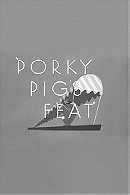
 32
32
 7.7
7.7
 7.7
7.7

